#influential filmmakers
Text






NOT ANOTHER THREE KINGDOMS ADAPTATION LMFAOOOOOO
#NO FR THERES ONE EVERY FEW YEARS THEY'RE *RIGHT*#legit this is such a fun movie... finally an ann hui film that's been solid the entire time ive been watching it HJFKGHJ#a simple life#also. i know shes a hugely influential filmmaker but the amnt of a-listers in this?? insane.#ling.txt
5 notes
·
View notes
Text
The Greatest Fantasy Movies of All Time
Welcome to my sweeping cinematic journey, where I traverse the enchanting and ever-evolving world of fantasy films.
From the pioneering days of silent movies to the dazzling digital masterpieces of the 2020s, the fantasy genre has continuously captivated audiences with its unique blend of magic, myth, and imagination.
In this comprehensive exploration, I’ll delve into the landmark films and…
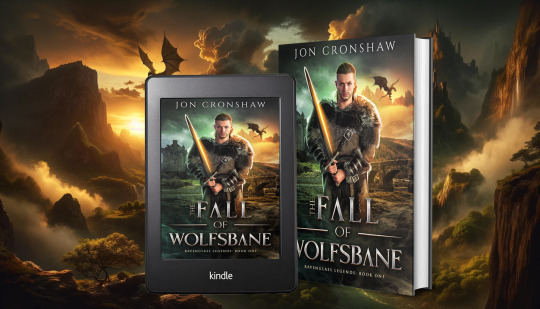
View On WordPress
#classic fantasy movies#digital era fantasy films#evolution of fantasy cinema#fantasy cinema evolution#fantasy cinema history#fantasy directors#fantasy film technology#fantasy filmmaking#fantasy genre analysis#fantasy in cinema#fantasy movie effects#fantasy movie timeline#fantasy visual effects#history of fantasy films#iconic fantasy films#influential fantasy movies#modern fantasy movies#silent era fantasy films#top fantasy movies
0 notes
Text
God I love animation. I love it for the way it can bring anything to life beyond the constraints of boring ol' reality, but also the ways that it's inextricably linked to, and draws on the conventions of live-action film-making.
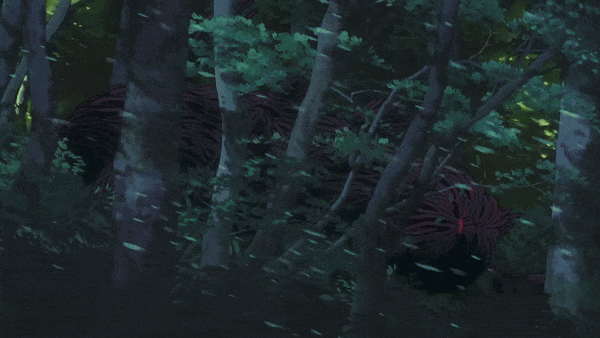
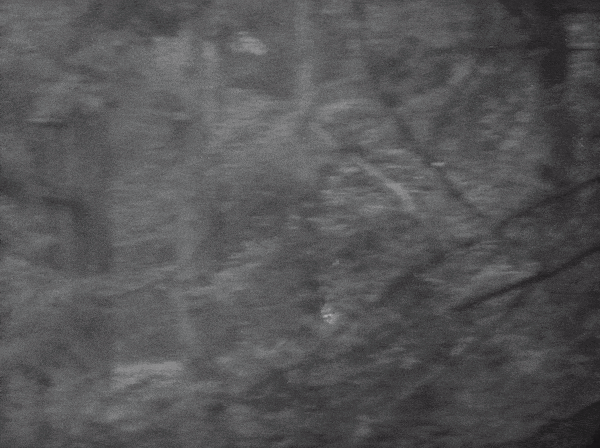
So fuck it, let's look at how Hayao Miyazaki straight up copies some camera framing techniques from his predecessor and the other most influential Japanese filmmaker of all time, Akira Kurosawa! (Kurosawa really was the master of framing scenes around his characters, so he's a great source of inspiration)
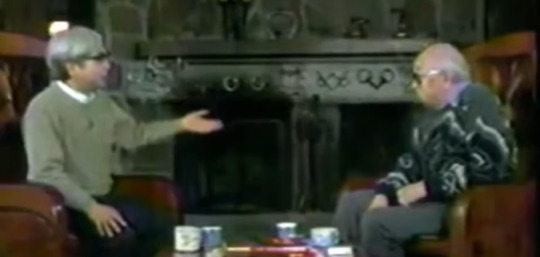
(btw, this is a screenshot from this TV special where the two met for the first time just after the release of Kurosawa's final film. It's pretty interesting, and also very cute how nervous Miyazaki seems to be to meet one of his idols.)
Specifically, how the two each choose to break the 180 degree rule (well, not technically 'break' in the case of Kurosawa) to show their protagonists' changing destiny in "Throne of Blood" and "Princess Mononoke".
For anyone who doesn't know, the 180 degree rule is a basic film-making rule of thumb which states that in any scene where two characters interact, you should draw an imaginary line between them and the camera should always stay on one side of that line.

("In the Mood for Love" - Wong Kar-wai)
This way, one character is always looking to the right of the camera, the other is always looking to the left, and the audience doesn't get confused by the geography of the scene. Crossing this line can be disorienting, but when done intentionally, it can convey a paradigm shift of some kind in the scene.

In this scene from "Throne of Blood," (a feudal Japanese retelling of Macbeth) Washizu's wife Asaji discusses tactics with him and tries to convince him to aspire to the throne and to assassinate his lord Tsuzuki while he sleeps.
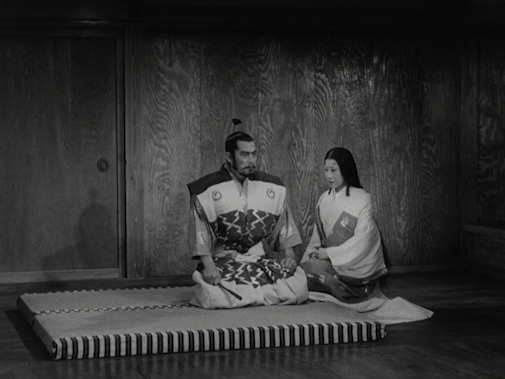
As two servants appear to notify them that Washizu's sleeping quarters are prepared, the camera dollies left and around the characters' backs. This camera movement is motivated by the motion of the servants' torches outside the room, but it also signifies a change in Washizu's outlook.
Washizu is completely silent for most of this scene, contemplating his wife's advice. But as the camera slides behind his back and across the line of action, the scene is now re-framed, illustrating his change in perspective.
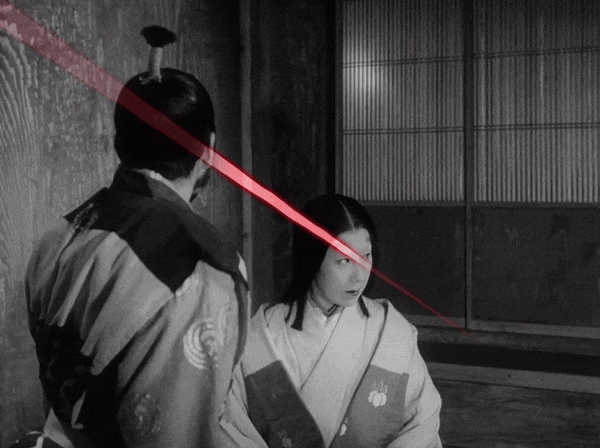
He's been convinced and the trajectory of his life is about to change - and now, facing away from the camera, is the time for action.
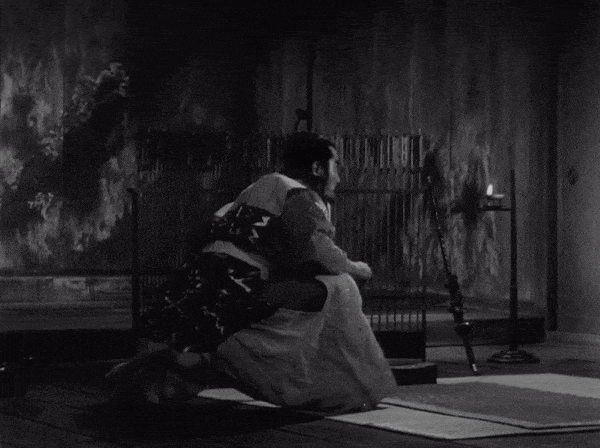
Because the camera slides smoothly across the line, Kurosawa isn't technically breaking the 180 degree rule. Miyazaki on the other hand, takes it a little further.
The complimentary scene in Princess Mononoke comes near the start when the wise woman of the village reads Prince Ashitaka's fortune after he's cursed by the wild boar spirit. She tells him that it is his fate to leave the village and travel to the west, where he may be able to lift the curse on his arm. The trajectory of Ashitaka's life changes in this moment too. As he accepts his fate, the change is symbolized by him cutting off his hair, but also by the camera jumping the line.
Throughout this dialogue scene and even as he cuts his hair, the simulated camera sits just slightly to the side of Ashitaka's left shoulder.
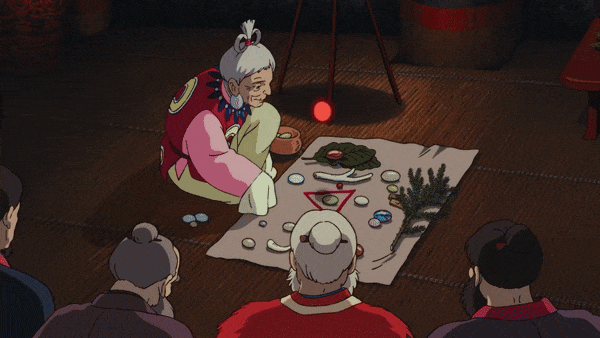
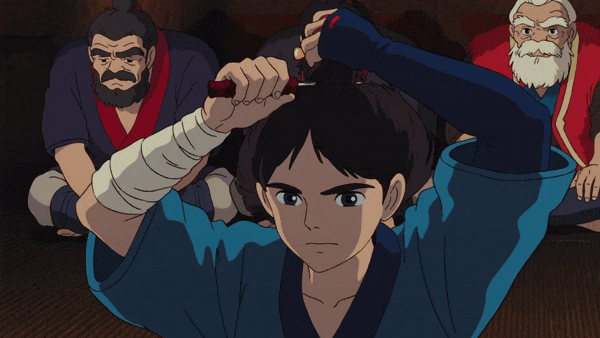
But once it's done, for the final shot, the scene is reframed and we jump to the other side, where Ashitaka is now looking to the right of the camera instead of the left.
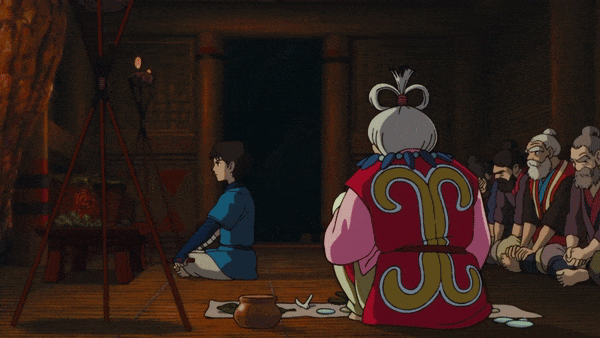
Making the camera dolly across a scene like Kurosawa's version in 2D animation is no simple task, so this transition with a simple cut is in a way subtler, in another way a bit more jarring, but it conveys the same meaning.
This is the moment when our protagonists make the choice to embark on a new destiny and re-frame their lives.
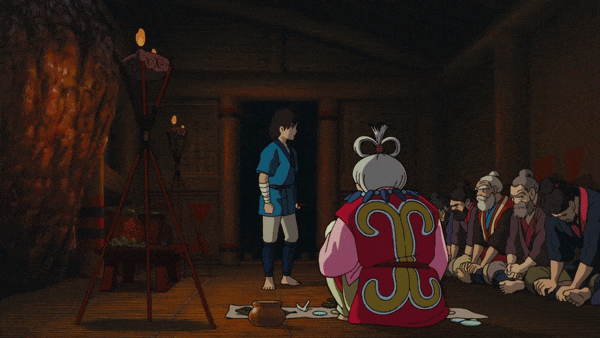
This has been an excerpt from a short video essay I made a while back, which not many people watched. I think this is at least in part due to my failure to package it well, and it seems you tumblheads like this animation/cinematography analysis stuff, so this is an experiment to see if, with the help of y'all, and a new title and thumbnail, it's at all possible to give this video a second wind in the eyes of the Youtube Gods!
So if you found this interesting, I'd appreciate if you checked it out! Thanks for reading!
youtube
#Also i spent a lot of time on the little animated bit at the start so please watch it lol#animation analysis#mini essay#video#video essay#princess mononoke#throne of blood#hayao miyazaki#akira kurosawa#Youtube#gif warning
1K notes
·
View notes
Text
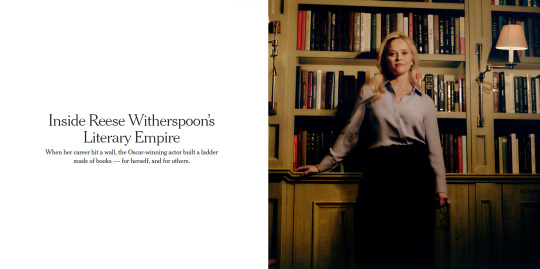
By Elisabeth Egan
May 18, 2024
“You’d be shocked by how many books have women chained in basements,” Reese Witherspoon said. “I know it happens in the world. I don’t want to read a book about it.”
Nor does she want to read an academic treatise, or a 700-page novel about a tree.
Sitting in her office in Nashville, occasionally dipping into a box of takeout nachos, Witherspoon talked about what she does like to read — and what she looks for in a selection for Reese’s Book Club, which she referred to in a crisp third person.
“It needs to be optimistic,” Witherspoon said. “It needs to be shareable. Do you close this book and say, ‘I know exactly who I want to give it to?’”
But, first and foremost, she wants books by women, with women at the center of the action who save themselves. “Because that’s what women do,” she said. “No one’s coming to save us.”
Witherspoon, 48, has now been a presence in the book world for a decade. Her productions of novels like “Big Little Lies,” “Little Fires Everywhere” and “The Last Thing He Told Me” are foundations of the binge-watching canon. Her book club picks reliably land on the best-seller list for weeks, months or, in the case of “Where the Crawdads Sing,” years. In 2023, print sales for the club’s selections outpaced those of Oprah’s Book Club and Read With Jenna, according to Circana Bookscan, adding up to 2.3 million copies sold.
So how did an actor who dropped out of college (fine, Stanford) become one of the most influential people in an industry known for being intractable and slightly tweedy?
It started with Witherspoon’s frustration over the film industry’s skimpy representation of women onscreen — especially seasoned, strong, smart, brave, mysterious, complicated and, yes, dangerous women.
“When I was about 34, I stopped reading interesting scripts,” she said.
Witherspoon had already made a name for herself with “Election,” “Legally Blonde” and “Walk the Line.” But, by 2010, Hollywood was in flux: Streaming services were gaining traction. DVDs were following VHS tapes to the land of forgotten technology.
“When there’s a big economic shift in the media business, it’s not the superhero movies or independent films we lose out on,” Witherspoon said. “It’s the middle, which is usually where women live. The family drama. The romantic comedy. So I decided to fund a company to make those kinds of movies.”
In 2012, she started the production company Pacific Standard with Bruna Papandrea. Its first projects were film adaptations of books: “Gone Girl” and “Wild,” which both opened in theaters in 2014.
Growing up in Nashville, Witherspoon knew the value of a library card. She caught the bug early, she said, from her grandmother, Dorothea Draper Witherspoon, who taught first grade and devoured Danielle Steel novels in a “big cozy lounger” while sipping iced tea from a glass “with a little paper towel wrapped around it.”
This attention to detail is a smoke signal of sorts: Witherspoon is a person of words.
When she was in high school, Witherspoon stayed after class to badger her English teacher — Margaret Renkl, now a contributing opinion writer for The New York Times — about books that weren’t part of the curriculum. When Witherspoon first moved to Los Angeles, books helped prepare her for the “chaos” of filmmaking; “The Making of the African Queen” by Katharine Hepburn was a particular favorite.
So it made sense that, as soon as Witherspoon joined Instagram, she started sharing book recommendations. Authors were tickled and readers shopped accordingly. In 2017, Witherspoon made it official: Reese’s Book Club became a part of her new company, Hello Sunshine.
The timing was fortuitous, according to Pamela Dorman, senior vice president and publisher of Pamela Dorman Books/Viking, who edited the club’s inaugural pick, “Eleanor Oliphant is Completely Fine.” “The book world needed something to help boost sales in a new way,” she said.
Reese’s Book Club was that something: “Eleanor Oliphant” spent 85 weeks on the paperback best-seller list. The club’s second pick, “The Alice Network,” spent nearly four months on the weekly best-seller lists and two months on the audio list. Its third, “The Lying Game,” spent 18 weeks on the weekly lists.
“There’s nothing better than getting that phone call,” added Dorman, who has now edited two more Reese’s Book Club selections.
Kiley Reid’s debut novel, “Such a Fun Age,” got the nod in January 2020. She said, “When I was on book tour, a lot of women would tell me, ‘I haven’t read a book in four years, but I trust Reese.’” Four years later, on tour for her second novel, “Come and Get It,” Reid met women who were reading 100 books a year.
Witherspoon tapped into a sweet spot between literary and commercial fiction, with a few essay collections and memoirs sprinkled in. She turned out to be the literary equivalent of a fit model — a reliable bellwether for readers in search of intelligent, discussion-worthy fare, hold the Proust. She wanted to help narrow down the choices for busy readers, she said, “to bring the book club out of your grandma’s living room and online.”
She added: “The unexpected piece of it all was the economic impact on these authors’ lives.”
One writer became the first person in her family to own a home. “She texted me a picture of the key,” Witherspoon said. “I burst into tears.”
Witherspoon considers a handful of books each month. Submissions from publishers are culled by a small group that includes Sarah Harden, chief executive of Hello Sunshine; Gretchen Schreiber, manager of books (her original title was “bookworm”); and Jon Baker, whose team at Baker Literary Scouting scours the market for promising manuscripts.
Not only is Witherspoon focused on stories by women — “the Bechdel test writ large,” Baker said — but also, “Nothing makes her happier than getting something out in the world that you might not see otherwise.”
When transgender rights were in the headlines in 2018, the club chose “This Is How It Always Is,” Laurie Frankel’s novel about a family grappling with related issues in the petri dish of their own home. “We track the long tail of our book club picks and this one, without fail, continues to sell,” Baker said.
Witherspoon’s early readers look for a balance of voices, backgrounds and experiences. They also pay attention to the calendar. “Everyone knows December and May are the busiest months for women,” Harden said, referring to the mad rush of the holidays and the end of the school year. “You don’t want to read a literary doorstop then. What do you want to read on summer break? What do you want to read in January?”
Occasionally the group chooses a book that isn’t brand-new, as with the club’s April pick, “The Most Fun We Ever Had,” from 2019. When Claire Lombardo learned that her almost-five-year-old novel had been anointed, she thought there had been a mistake; after all, her new book, “Same As it Ever Was,” is coming out next month. “It’s wild,” Lombardo said. “It’s not something that I was expecting.”
Sales of “The Most Fun We Ever Had” increased by 10,000 percent after the announcement, according to Doubleday. Within the first two weeks, 27,000 copies were sold. The book has been optioned by Hello Sunshine.
Witherspoon preferred not to elaborate on a few subjects: competition with other top-shelf book clubs (“We try not to pick the same books”); the lone author who declined to be part of hers (“I have a lot of respect for her clarity”); and the 2025 book she’s already called dibs on (“You can’t imagine that Edith Wharton or Graham Greene didn’t write it”).
But she was eager to set the record straight on two fronts. Her team doesn’t get the rights to every book — “It’s just how the cookie crumbles,” she said — and, Reese’s Book Club doesn’t make money off sales of its picks. Earnings come from brand collaborations and affiliate revenue.
This is true of all celebrity book clubs. An endorsement from one of them is a free shot of publicity, but one might argue that Reese’s Book Club does a bit more for its books and authors than most. Not only does it promote each book from hardcover to paperback, it supports authors in subsequent phases of their careers.
Take Reid, for instance. More than three years after Reese’s Book Club picked her first novel, it hosted a cover reveal for “Come and Get It,” which came out in January. This isn’t the same as a yellow seal on the cover, but it’s still a spotlight with the potential to be seen by the club’s 2.9 million Instagram followers.
“I definitely felt like I was joining a very large community,” Reid said.
“Alum” writers tend to stay connected with one another via social media, swapping woot woots and advice. They’re also invited to participate in Hello Sunshine events and Lit Up, a mentorship program for underrepresented writers. Participants get editing and coaching from Reese’s Book Club authors, plus a marketing commitment from the club when their manuscripts are submitted to agents and editors.
“I describe publishing and where we sit in terms of being on a river,” Schreiber said. “We’re downstream; we’re looking at what they’re picking. Lit Up gave us the ability to look upstream and say, ‘We’d like to make a change here.’”
The first Lit Up-incubated novel, “Time and Time Again” by Chatham Greenfield, is coming out from Bloomsbury YA in July. Five more fellows have announced the sales of their books.
As Reese’s Book Club approaches a milestone — the 100th pick, to be announced in September — it continues to adapt to changes in the market. Print sales for club selections peaked at five million in 2020, and they’ve softened since then, according to Circana Bookscan. In 2021, Candle Media, a Blackstone-backed media company, bought Hello Sunshine for $900 million. Witherspoon is a member of Candle Media’s board. She is currently co-producing a “Legally Blonde” prequel series for Amazon Prime Video.
This month, Reese’s Book Club will unveil an exclusive audio partnership with Apple, allowing readers to find all the picks in one place on the Apple Books app. “I want people to stop saying, ‘I didn’t really read it, I just listened,’” Witherspoon said. “Stop that. If you listened, you read it. There’s no right way to absorb a book.”
She feels that Hollywood has changed over the years: “Consumers are more discerning about wanting to hear stories that are generated by a woman.”
Even as she’s looking forward, Witherspoon remembers her grandmother, the one who set her on this path.
“Somebody came up to me at the gym the other day and he said” — here she put on a gentle Southern drawl — “‘I’m going to tell you something I bet you didn’t hear today.’ And he goes, ‘Your grandma taught me how to read.’”
Another smoke signal, and a reminder of what lives on.
#reese witherspoon#reese's book club#reading#literary#club#book#new york times#elisabeth egan#article
196 notes
·
View notes
Text
Still in awe of the speed and ferocity and tenacity with which virtually the entire modern "filmmaking" establishment in Hollywood went after Martin Scorsese, one of the most celebrated and influential movie directors ever, cause he said once he didn't like superhero movies, a grudge that still hasn't abated to this day.
#the desperation and neediness MCU sludgemakers have for their 'work' getting recognition is just#lol#you already have fuckzillions of dollars you really need to get your dick sucked by every last person on the planet too??
2K notes
·
View notes
Text
SandRay are an homage to Wong Kar-Wai's Happy Together and in this essay I will..
...actually explain it because I see people catching his homage's to Western queer media, but not really his shout outs to Eastern queer media.
I assumed there would be allusions to Happy Together when I first saw the trailer, but this last episode centered around Ray really cemented it for me. After all, why would P'Jojo reference all these Western queer shows and not talk about what is probably the most iconic piece of Eastern queer media ever?

Wong Kar-Wai & Happy Together
For some background information, Wong Kar-Wai is a famous and insanely influential Hong Kong filmmaker. If you're a film nerd, you probably know who he is and recognize his style. If you like film and metas, I would recommend watching some of his stuff because afterwards, you'll realize just how much influence he still has on modern media, especially in Asia. Stylistically, he's known for rich color grading; thematic usage of music; an unending sense of nostalgia, heartbreak, and missed opportunities; and dialogue that mean nothing on the surface because everything meaningful is boiling just under, left unsaid (If you've watched Everything Everywhere, All At Once, the entire actress universe sequence was an homage to Wong Kar-Wai). His actors always do a phenomenal job because so much of what they need to portray can't be communicated through words. It makes sense why SandRay, aka FirstKhao, were chosen to represent Happy Together as they are the strongest actors out of the group.
Happy Together, simply summarized, is about two men, Ho Po-Wing and Lai Yiu-Fai, who are in a very tumultuous relationship. They end up in Argentina because they wanted to visit the waterfall that's on a lamp that they own. They get lost, end up using all their money, and have to figure out a way to get back to Hong Kong. While there, they break up, get back together, and break up again.
The movie was released in 1997 and is still ranked as one of the best queer movies of all time. The two main characters are played by Tony Leung and Leslie Cheung. You might recognize Tony Leung as Simu Liu's dad in Shang-Chi. Leslie Cheung was in Farewell, My Concubine, and was famously a bisexual man with a long term male partner. This is significant because it was virtually unheard of to be out and open at that time (he made his relationship public in 1997 though he had mentioned bisexuality in earlier years), especially in Hong Kong which was, and still is, very homophobic. Leslie received a lot of hate for his sexuality and androgyny. (If you're interested in learning more about Leslie as a queer Asian figure, this is a good video essay that goes over his work and his life).
Sand as Lai Yiu-Fai
Fai's, and in turn Sand's, character can be summed up by one line, "One thing I never told Ho Po-Wing was that I didn't want him to recover so fast. Those were our happiest days."
Both Fai and Sand are very static, straightforward characters. They stay above board for the most part and work a variety of jobs to survive. They have their morals about what is right and wrong, which unfortunately is both of their downfalls.
In Happy Together, Wing breaks up with Fai because he is bored with the relationship. He basically says, "I'm bored being with you. Let's break up. If we happen to meet again, we can try again." Then he leaves Fai stranded on the side of a highway.
Later, he reappears in Fai's life. The first encounter is a fight, much like Sand and Ray's first meeting in the bathroom. The second encounter is because Wing gets beaten up. He goes to Fai because he knows Fai will feel obligated to take care of him and he does. It becomes the beginning of their rekindled relationship.
Similarly, Sand has a strong sense of obligation. There are already metas out there about how Sand has a bit of a hero complex. He sees Ray too drunk to drive and he had to step in. He doesn't just take the keys and order a taxi. No, he takes the keys and drives Ray. Sand sees Ray being all sad and pathetic and he can't stop himself from helping. It makes him feel useful. It makes him feel needed.
Both of these men are caretakers. They show affection by providing care. Sand ends up cooking for Ray just as Fai cooks for Wing even when he's sick. As an added bonus, they both make fried rice.



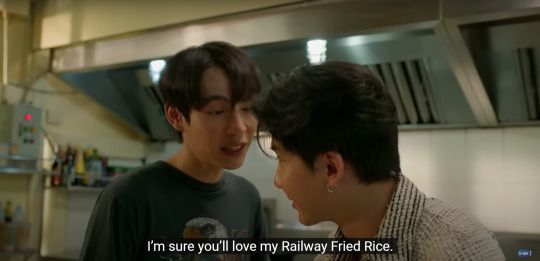
Both Sand and Fai are characters that stand completely still. Ray and Wing always know where to find them. Sand can always be found at YOLO and Fai is at his apartment. Because of this, Ray and Wing come and go as they please. They know that Sand and Fai will take them back...until they finally don't.
Ray as Ho Po-Wing
Starting on a base level, both characters are bratty, needy, promiscuous, spoiled, and selfish. But most importantly, they both share a love of fluffy cardigans.

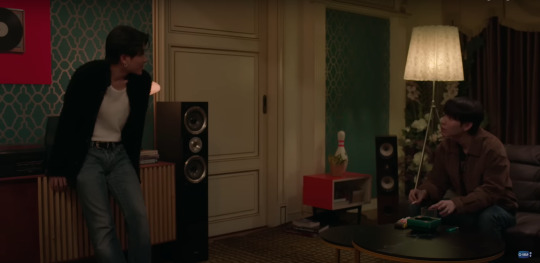
(I also have a theory they keep putting Ray in wife beaters as an homage to the 90's HK cinema style because otherwise...I just don't understand why, as a rich asshole, he's always in wife beaters. By Thai BL logic, he should be in shirts with too many buttons unbuttoned.)
Wing and Ray are both the ones controlling the pace and direction of the relationship. They come when they need someone to nurture their wounds, both physically and metaphorically. They leave when they're bored or have things they deem more important. They both initiate intimacy and won't take no for an answer.


Wing does this by first trying to join Fai on the couch and then chasing after him to the bed and begging him to let them sleep together.
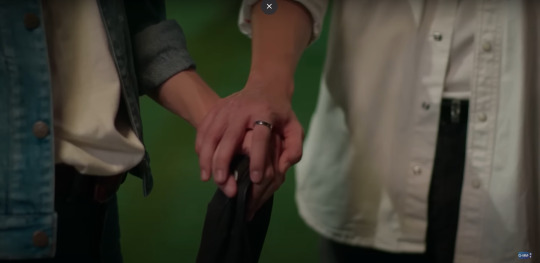
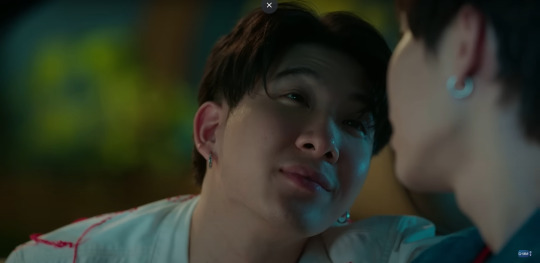
Ray does it by continuously getting Sand to get in the car with him and then using his puppy dog eyes.
They are both also very, very pouty.
Wing's line is "We could start over". He says it every time he comes back after he's the one that ends the relationship. Fai always fights taking him back, but he always does it anyway.
Ray doesn't really have a line yet (unless you count his "na na naa~"s) but he bats his eyelashes and so far Sand has given into him every time. Sand keeps trying to set boundaries, but the moment Ray begs a little bit, Sand crumbles like a house of cards and lets Ray have whatever he wants.
Relationship Parallels
Wong Kar-Wai is known for making movies about star crossed lovers who are meant for each other, but aren't meant to be together.
Like Wing and Fai, Sand and Ray fill in each other's cracks in a way that complements each other. However, because of the nature of the cracks themselves, them complementing each other is exactly what makes the relationship so toxic. One stays and one goes. One takes and one gives. One is steady and one is flighty.
Most of what I wanted to say about the parallels between their relationships is in the character comparison. What I'm more interested in is the future of SandRay's relationship, especially if they continue to parallel Wing and Fai's in Happy Together.




Obviously, Wing and Fai don't end up together at the end. It wouldn't be a Wong Kar-Wai movie if they did. What is interesting is that Fai's relationship with Wing eventually pushes him into becoming something angry and spiteful. Once Wing heals, Fai knows that he'll become bored and want to leave. In an attempt to get him to stay, he steals and hides Wing's passport which is insane because they are both gay men stuck in a foreign country where they don't speak the language.
Wing, of course, leaves anyway.
There is also a third character, Chang, whom Fai ended up liking. These new feelings are what eventually pushes Fai to leave Argentina and move on from Wing and move on with his life.
The question is, if SandRay follows that same path as Happy Together, what will be the passport that Sand tries to hold over Ray and who will be Sand's Chang?
Stylistic Parallels
Smoking
Making Ray and Sand smoke is definitely an homage to Happy Together with the added bonus of being a metaphor. For the most part, we rarely see characters, especially main characters, smoke in Asian media because smoking is reserved for 'bad' characters.
Cigarettes in Happy Together represent boredom. Fai and Wing smoke at the beginning before they rekindle their relationship because they are just moving through life. Once Fai and Wing get back together, cigarettes stop making an appearance. It isn't until their relationship started deteriorating that we see the men smoking again.
This can also be said about Sand Ray's relationship. They started their 'involvement' with cigarettes. However, the last time we actually see them smoking is in ep 2 right before they hook-up. Since then, we have not seen either of them smoking. This probably means that we'll see one or both of them smoking again when their relationship starts to break down.
(In the preview for ep 5, there is an ashtray in the background on the balcony so let's see if Boston finding out about them is a catalyst for them to start breaking down.)
And of course, there is the added homoeroticism of asking for a light.
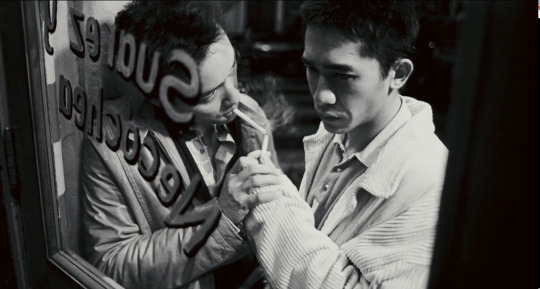

Ray's Opening and Closing Scenes
Ray's episode is really what made me go "I see you P'Jojo".
Ray's episode starts with a shot of him isolated and in emotional pain. The camera is claustrophobically close and it keeps moving around. He has a little voiceover opening. It's calm, it's contemplative, it's a little existential, and it is irrevocably sad. If that is not a Wong Kar-Wai staple, then idk what is. Even the song that starts playing gives me 80s, 90s Cantopop vibes.
Ray talks about how Mew being his emergency contact and the one he goes to. Fai talks about how Wing always comes back to him and says "Let's start over".


The movie and the episode ends with both of them once again isolated, alone. They've been through an emotional journey and they've technically moved on. But there's always the idea of not being able to fully let go in Wong Kar-Wai's movie. So just like how Fai has physically removed himself from Wing, but not emotionally, has Ray actually fully removed himself from Mew?


Cinematography
Then there's just a collection of scenes that reminded me very heavily of Happy Together and Wong Kar-Wai's style. I would have added pictures from his other movies for comparison, but Tumblr only lets me put 30 images in a post and I don't want to make a 2nd post.
This scene is specifically from the 1st trailer so I hope they keep it in the show.
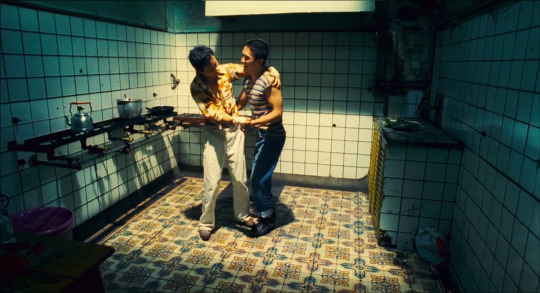

This one I call the inevitability of falling. Both Sand and Fai realize they're fully committed to their decision to take care of Ray and Wing here.


The end title card
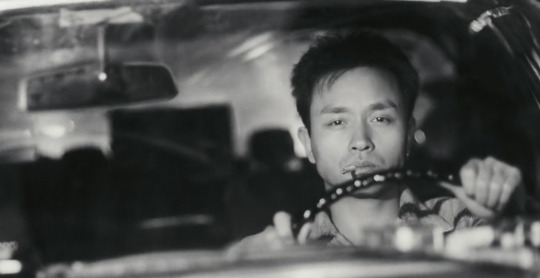

Actually, all of the end title cards give very Wong Kar-Wai vibes. Look at that saturated, neon color grading. Look at the elongated shots. The intense feeling of isolation.


I'm assuming we'll get all the characters at one point, but so far it looks like the end credit cards indicate who the narrator of each episode is.
Anyway, that's it for me! Sorry it was so long and rambling. I tried to organize my thoughts but as I was thinking, more thoughts would pop up and I'd get distracted. If you made it this far, thanks for reading!
#ofts#only friends the series#only friends series#sandray#ofts meta#only friends meta#happy together#i have to post this now because if i dont ill keep writing and ive already spent too much time on this#if anyone has other screenshot comparisons post them#because there are a few more scenes that give me major wong kar-wai vibes#but im too tired to look for them now
438 notes
·
View notes
Text

@claudiopogo and @wysocka.magdalena take-over @archivalzone with their project @the_stacks
stacks were shot over a couple of visits at the New York Public Library's Picture Collection @nyplpicturecollection
About the Picture Collection:
"Since its creation in 1915 as a resource for artists, Illustrators, designers, teachers, students, and general researchers, The New York Public Library's Picture Collection provides 1.5 million circulating images clipped from books and magazines across 12,000 subject headings, from clothing and dress to military battles to insects. The collection also features extensive holdings of prints, photographs, vintage postcards, and greeting cards, and around 150,000 non-circulating reference images from the early 1900s and prior. The Library has digitized 45,000 of these historic items as part of its online Digital Collections.
The Picture Collection's unique arrangement of items into subject headings makes it useful to researchers in many creative fields, including artists; documentary filmmakers; set, prop, and costume makers for stage and film; graphic novel writers; and fashion designers. The collection has provided inspiration and insight to some of the most well-known and influential visual artists in the world-including Diego Rivera, Andy Warhol, and Taryn Simon-and it continues to serve the needs of the creative community to this day." (Quoted from the Library's Website)
The project is a work in progress and intended to become a photobook published by @outerspacepress in the near future.
We hope you'll enjoy browsing this amazing archive of photography with us in the upcoming few days.
#New York Public Library#Magdalena Wysocka#The Stacks#Archival Zone#Found Photography#Archive#Archives#Collections#Eye#Eyes
64 notes
·
View notes
Text

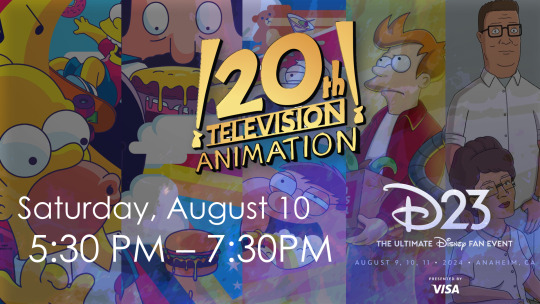
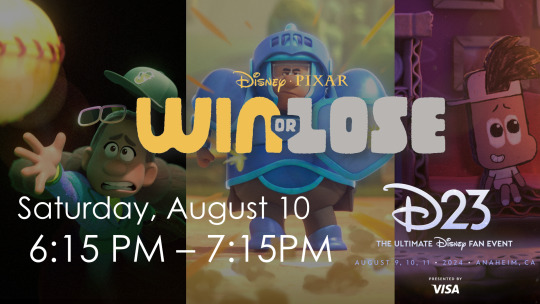

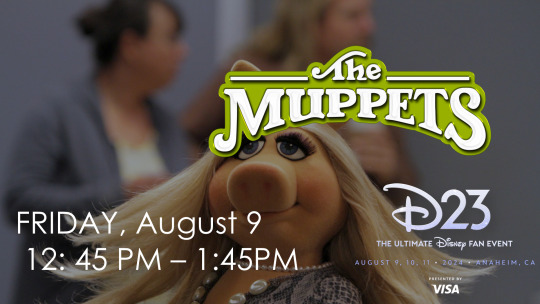
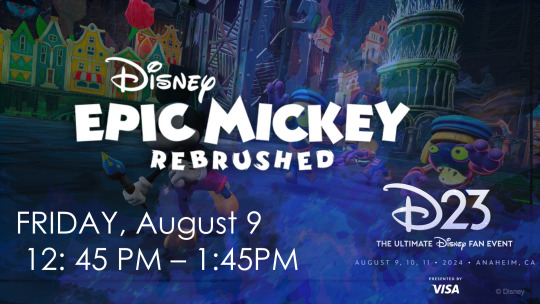


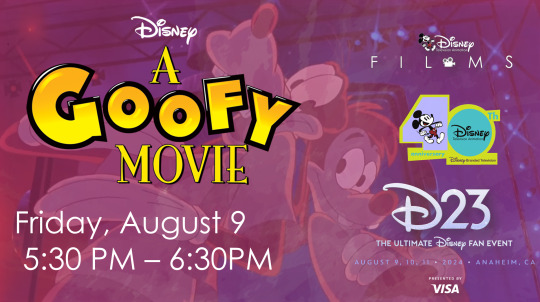
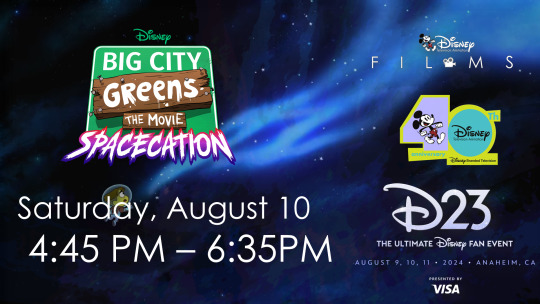
Disney Announces Jam-Packed D23 Fan Event Lineup With Many Animation, Muppets Panels And Screenings
With less than one month to go to the highly anticipated D23: The Ultimate Disney Fan Event presented by Visa, Disney today revealed details about what fans will be able to experience at the Anaheim Convention Center during this sold-out event, which will include an outstanding lineup of over 230 panels and presentations, show floor offerings and Talent Central interactions. This announcement builds upon plans previously shared about this year’s D23 gathering, which is set to be bigger and better than ever before.
Animation on Stage at D23
30 Years of Toy Story
Celebrate 30 Years of Toy Story with filmmakers and Pixar Legends as they reflect on the making of the groundbreaking classic nearly 30 years ago and share never-before-heard anecdotes about how the historic film came to be.
Exploring New Parts of the Mind: Behind the Design of Inside Out 2 + a Dreamy Surprise!
Join Inside Out 2 production designer Jason Deamer as he gives an in-depth look at designing the new emotions joining Headquarters as Riley enters teenagehood. And stick around for a special dreamy sneak peek of an upcoming Pixar series!
Marvel Animation Sneak Peek
See what’s coming next to Disney+ from Marvel Animation, with special guests and first looks at hotly anticipated series including Your Friendly Neighborhood Spider-Man, Eyes of Wakanda, future seasons of What If…?, X-Men ’97, and more!
The Animation Greats + Cast and Creator Sessions featuring Bob’s Burgers, Futurama and The Simpsons Presented by Hulu Animayhem & 20th Television Animation
Four of the most influential creators in the world of animation — Matt Groening (The Simpsons, Futurama), Seth MacFarlane (Family Guy, American Dad!), Mike Judge (King of the Hill) and Loren Bouchard (Bob’s Burgers, The Great North) — come together for a historic and extraordinary conversation you won’t want to miss. Then, the voice talent and creative teams behind Bob’s Burgers, Futurama, and The Simpsons take the stage to entertain with clips, conversation, and fan Q&A. Whether you’re a longtime fan or an aspiring animator, this is a must-see panel for all!
Behind the Summer Shenanigans with the Phineas and Ferb Creators
Join Dan Povenmire and Jeff “Swampy” Marsh, the masterminds behind the beloved animated show Phineas and Ferb as they look back at the creation and legacy of this pop culture phenomenon. Hear behind-the-scenes stories and get ready to laugh!
Making A Goofy Movie: The Road to Lake Destiny
The creatives behind the A Goofy Movie phenomenon reunite, reminisce, and share clips from a new documentary about the incredible origin story of this beloved cult classic.
Stay Tuned: You’re Watching Disney Channel
Join beloved Disney Channel stars on the Walt Disney Archives Stage for a look at some of the iconic series and movies that have created generations of fans. Stay tuned for laughs, fun and moments you won’t want to miss!
Big City Greens the Movie: Spacecation Screening
Blast off for a hilarious outer-space adventure with a screening of the animated comedy Big City Greens the Movie: Spacecation, introduced by the talented creative team, including creators and executive producers Chris and Shane Houghton.
Restoring Disney Animation Classics
Director of Restoration Kevin Schaeffer and Disney Animation artists Eric Goldberg and Michael Giaimo will delve into the history of Disney’s preservation program, showcase before-and-after clips, and share how classic films are brought back to life.
The Muppets 70: A Glamorous Miss Piggy Retrospective
Join Walt Disney Archives Director Becky Cline and The Muppets Producer Dani Iglesias for a fabulous look back on the past 70 years of the Muppets, but mostly Miss Piggy! We will dive into the vaults to uncover nostalgic artifacts along with how we preserve this collection today!
Disney Epic Mickey: Rebrushed – The Return of a Beloved Classic
Wield the paintbrush once more in Disney Epic Mickey: Rebrushed out this fall! Join Disney Games, Epic Mickey Creative Director Warren Spector, and more special guests, for a conversation that delves into how this beloved classic adventure came to life.
#D23#D23 Expo#D23 Expo 2024#Epic Mickey#The Muppets#Muppets#A Goofy Movie#Toy Story#Toy Story 5#Inside Out#Win Or Lose#Bob's Burgers#The Simpsons#Simpsons#Family Guy#American Dad#Futurama#King Of The Hill#Big City Greens#BCG#Phineas And Ferb#Zootopia#Zootopia 2#Moana#Moana 2#Big City Greens The Movie Spacecation#Big City Greens: The Movie Spacecation#Inside Out 2#Your Friendly Neighborhood Spider-Man#Eyes Of Wakanda
73 notes
·
View notes
Text
in a mundane au where the cult / the band dont exist and the family are never part of it, i think Terzo would be an influential filmmaker known for his gay experimental dystopian art films.
and i think Primo would be serving life in prison for being a serial killer-
50 notes
·
View notes
Text
The Astrology of Muses: A Vedic Exploration 🎨🖌👫💏
This is going to be a loooong post so hang in there besties<3
Claire Nakti observed that Ketu being the root or tail of the dragon is the source of our creativity. So whatever we channel during the process of art making is reflective of our Ketu, its placement etc. While I agree with this observation, I'd also like to add that Venus is also very important in determining the creativity, creative nature and career of an individual, as well as who or what they seek inspiration from.
Obviously Sun-Moon relationships and other aspects with luminaries can also determine how we connect to and draw inspiration from others.
First of all, let's understand what a muse is.
A muse is defined as a person (often, a woman but not always) who serves as a source of artistic inspiration creativity, and passion for the artist.
In mythology, the Muses were nine goddesses who symbolized the arts and sciences.
There is a spiritual reason why women serve as the source of creativity for others. This is because of them being Yin, inwardly expansive and vessels that can be receptive to a variety of influences. Water is the most feminine element and the ability of water to take the shape of whatever's its poured into is very important in this context. Water is life giving but it can also be destructive and turbulent. All of these are very telling about feminine nature.
Anyways, let's look through some artist-muse relationships in history and pop culture.
F Scott Fitzgerald and Zelda Fitzgerald

Probably one of the most famous literary romances. Zelda was Scott's lover, wife and muse. They had a very tumultuous marriage; Zelda was diagnosed with schizophrenia and Scott was an alcoholic but they also enjoyed immense popularity and success early on in their marriage and career.
It is now known that Scott plagiarized much of his work from the diaries and letters of his wife, Zelda and was controlling & abusive towards her when she expressed interest in furthering her own literary career.
Both of them had Mars in Mrigashira as their atmakaraka
Scott had Ketu in Ashlesha & his muse, Zelda was Ashlesha Rising (and mercury which was her amatyakaraka)
2. Vita Sackville West and Virginia Woolf

They were both married to different men when they began their affair with each other. They significantly influenced each other's work; Vita wrote Seducers In Ecuador dedicated to Virginia, while Virginia's Orlando was about Vita. The relationship lasted until Virginia's death in 1941.
Vita was Uttara Ashada Rising, whereas Virginia had Venus in Uttara Ashada
Vita had Venus in Aswini and Virginia was Aswini Moon
3. Ingrid Bergman & Roberto Rossellini
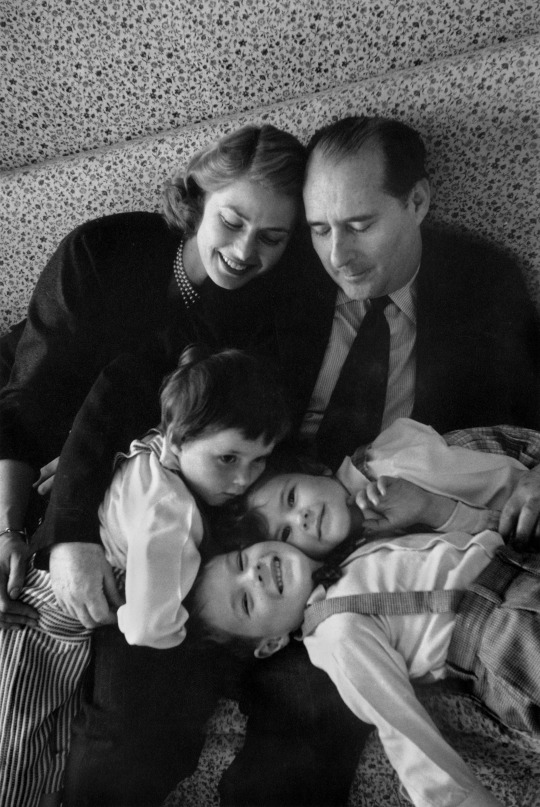
They began an affair when she was still married to her husband whilst filming the movie Stromboli. She got pregnant and they later got married.
While the movies Bergman made with Rossellini were commercial failures, the films have garnered great appreciation and attention for their contribution to Italian Neo-realism.
Bergman was Magha Sun, Venus & Rising, whereas Rossellini was Magha Rising
He had Rahu in Ashlesha and she had Ketu in Ashlesha
4. Lillian Gish & D.W Griffith

Lillian Gish is called "The First Lady of American Cinema"; she was a muse to the first influential filmmaker in Hollywood, D.W. Griffith. She appeared in his ground breaking movies The Birth of a Nation (1915), Intolerance (1916), Broken Blossoms (1919) and Way Down East (1920).
D.W Griffith was Ashlesha Moon with Mars in Vishaka atmakaraka and Ketu in Chitra
Lillian Gish had Chitra Sun, Venus & Saturn (amatyakaraka) in Vishaka and Ketu in Ashlesha
5. Norma Shearer & Irving Thalberg

Norma Shearer would be dubbed the First Lady of MGM for not only being the contracted actress with the most box-office appeal but also the wife of studio head Irving Thalberg.
Thalberg, was a film executive who was called the “boy wonder of Hollywood” who, as the production manager of MGM, was largely responsible for the studio’s prestigious reputation.
Shearer and Thalberg were married in 1927, after which Shearer had her pick of films, parts, costars, and directors, and she used this advantage to avoid being typecast. Thalberg largely directed her career until his death in 1936.
She played sexually liberated ingenues in the 1920s & 30s and is now considered a feminist icon.
She was Ashlesha Sun (atmakaraka), Venus & Mars in Ardra and Ketu in Rohini
He was Rohini Sun, Mars in Ashlesha (amatyakaraka) and Ketu in Ardra
5. Godard and Anna Karina

Karina served as a cinematic muse to Godard, appearing in eight of his films; during their five-year marriage and after. Karina liked being the muse, stating in 2016: "How could I not be honoured? Maybe it's too much, it sounds so pompous. But of course, I’m always very touched to hear people say that. Because Jean-Luc gave me a gift to play all of those parts. It was like Pygmalion, you know? I was Eliza Doolittle and he was the teacher."
Their contribution to the French New Wave and to cinema in general is widely acknowledged and well-regarded.
Karina was Ashlesha Venus (amatyakaraka), Punarvasu Rising with Ketu in Revati
Godard was Ashlesha Mars (amatyakaraka), Jupiter in Punarvasu (amatyakaraka) with Rahu in Revati
6. Monica Vitti & Michelangelo Antonioni

For 10 years, Monica Vitti was the muse and lover of Michelangelo Antonioni for almost a decade, starring in many of his most famous films, such as L’Avventura (1960), La Notte (1961), L’Eclisse (1962) & Red Desert (1964).
Vitti is Swati Sun with Ketu in Hasta
Antonioni has Hasta Sun, Mercury & Ketu along with his Venus in Swati
7. YSL & Paloma Picasso

Yves Saint Laurent had many muses but perhaps his most overlooked muse is Paloma Picasso
Paloma Picasso was the muse, who originally inspired Saint Laurent’s ‘Scandal’ collection of ‘71, and his career-defining turn away from the perfectionism of couture to a different kind of empowerment of something more wild, free and personal.
YSL was Uttarashada moon (atmakaraka), Paloma had Uttarashada moon & jupiter (conjunct)
8. Hubert de Givenchy and Audrey Hepburn

Givenchy designed the iconic 'little black dress' worn by Hepburn in Breakfast at Tiffany's, which cemented the actress as one of the most stylish women of the 20th century.
"His are the only clothes in which I am myself. He is far more than a couturier, he is a creator of personality," said Hepburn. The Breakfast at Tiffany's dress also helped Givenchy gain worldwide recognition, and his intricate, feminine designs became the subject of adoration.
Givenchy is Shatabhisha Sun & Jupiter
Audrey is Shatabhisha Moon
9. Bob Mackie and Cher

Mackie is a costume designer. His work with Cher has a place in fashion history, from the sheer dress she wore to the 1974 Met Gala to the beaded see-through gown she wore to accept her Oscar in 1988 (let alone, designing hundreds of her costumes for The Sonny & Cher Show).
Mackie has Ketu in Bharani and Cher has Mercury in Bharani (amatyakaraka)
10.Jean Paul Gaultier and Madonna
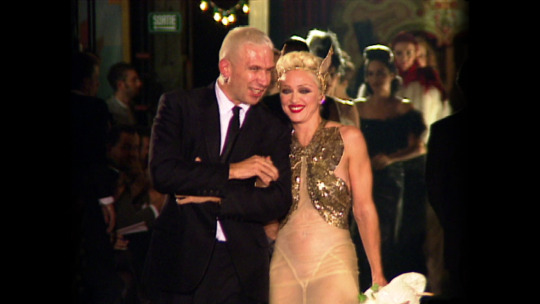
The cone bra—one of Madonna's most famous and recognised stage outfits from her Blonde Ambition tour—was created by Jean Paul Gaultier in 1990. The piece soon launched Gaultier's career, and solidified his relationship with the iconic performer.
Gaultier went on to design stage outfits for many of Madonna's concert tours, and she even made an appearance as a model in his spring summer '95 collection. After almost 30 years of friendship, they attended the 2018 Met Gala together (Madonna wearing one of Gaultier's designs, of course).
Gauthier is Bharani Moon & Madonna is Purva phalguni Moon & Rising
This is an example of Venus attracting & partnering with Venus.
11. Pedro Almodovar and Penelope Cruz
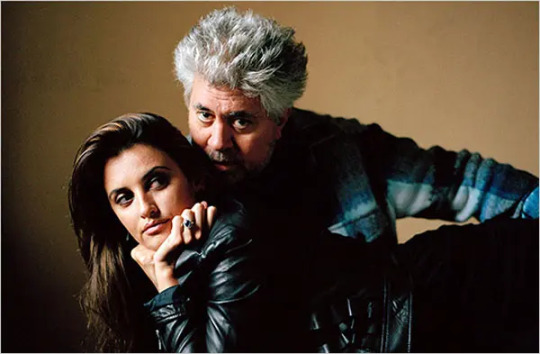
They've done numerous movies together in the last 25 years. They are both Punarvasu Moon
Almodovar is a Purvaphalguni Mercury (amatyakaraka) and Ketu and Penelope is a Bharani Sun, so this is yet another Venusian creative partnership.
When it comes to artist-muse partnerships, sharing Ketu/Venus to Sun/Moon/Rising aspects seems to be very common. Its also common to see artists and their muses share the same luminaries. We are inspired by people who project our qualities in different ways. there is a reason we are drawn to certain people and its always because of how subconsciously they remind us of ourselves.
social muses, trendsetters & it girls
I'm not going to mention Audrey Hepburn, Marilyn Monroe or Princess Diana because I feel like enough has been said about them.
There are some people who seem to inspire not just one person specifically but the tastes and culture of a whole era. They are tastemakers who set trends and are widely imitated and their influence has far reaching impact. They are "muse" to everybody.
Jackie O
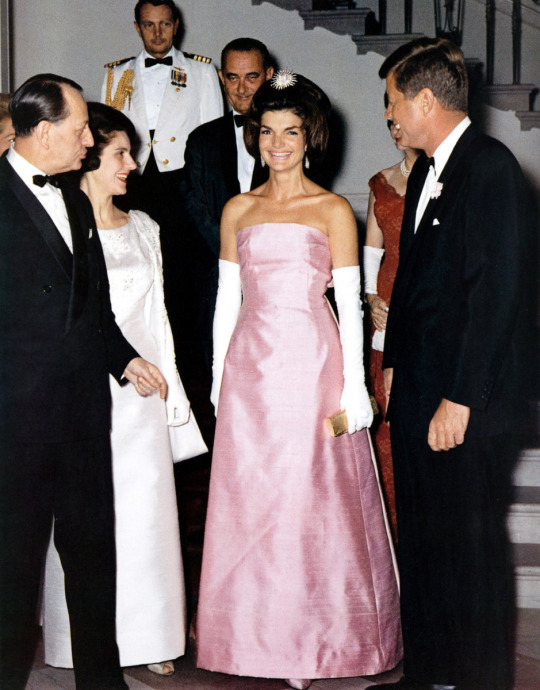
she is one of the most culturally influential people of the 20th century and defined her era (60s America) and is probably an early example of an "influencer", which is to say, people imitated her style, her manners etc
Jackie is Pushya Sun & Mercury, Aswini Moon, Ketu & Rising in Vishaka, Venus in Mrigashira atmakaraka.
2. Grace Kelly aka Princess Grace of Monaco

She is synonymous with elegance, flair and grace to this day and is widely regarded for her artistic success as well as her charitable endeavours. She is one of the most influential women in history.
She has Vishaka Sun (amatyakaraka) & Mars, Purvabhadrapada Moon, Swati Mercury, Ketu and Rising
3. Liz Taylor

Liz Taylor was known for her love of diamonds. She always dressed like a movie star, in very extravagant style with her plunging necklines, fur wraps, feather boas, and eye-catching headpieces. She was very glamorous
She was the first celebrity to have her own fragrance and thirty five years later, her perfume empire remains one of the most successful celebrity fragrance ventures of all time. White Diamonds is one the best selling celebrity fragrances in history. She paved the way for numerous others to follow in her foot steps, although not everyone has had her success.
She is Shatabhisha Sun & Mercury, Vishaka Moon, Jyeshta Rising along with Venus in Revati atmakaraka and Jupiter in Ashlesha amatyakaraka
4. Twiggy

She is the world's first supermodel. She is an important cultural icon and was the face of the Swinging Sixties in her babydoll dresses and mary janes.
She's Pushya Moon & Mars, and Punarvasu Rising
5. Diana Ross
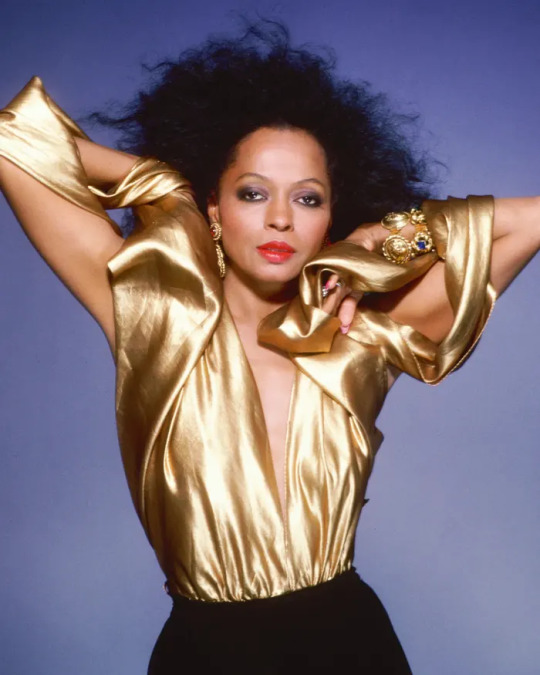
Miss Ross rose to fame as the lead singer of the girl group the Supremes, which became Motown's most successful act in the 1960s, and one of the world's best-selling girl groups of all time. After leaving the group in 1970, she launched a successful solo career, with many huge hits across the next couple of decades. She is known for her extravagant style and is a true 80s diva who blurred the lines between costumes and everyday clothing.
She is UBP Sun, Bharani Moon, Vishaka Rising
Mercury in Revati amatyakaraka and Jupiter in Ashlesha atmakaraka
6. Beyonce

Beyonce is one of the most influential women of the 21st century. Her impact on culture is immense and undeniable.
She is Purvaphalguni Sun, Vishaka Moon (atmakaraka) & Chitra Rising
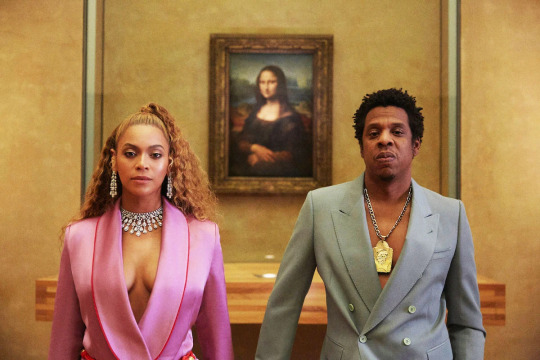
Bey & Jay have been each other's muses for a good while and have multiple albums inspired by each other. They are pop culture royalty.
Jay is Jyeshta Sun & Mercury (atmakaraka), Hasta Moon, Ketu & Rising in Purvaphalguni
7. Rihanna
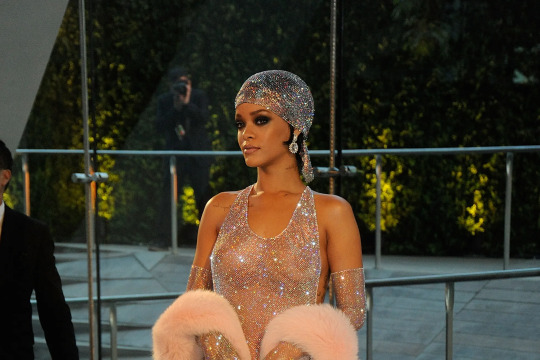
RiRi is one of the most iconic women ever.
Her music, looks, products, personality- everything about her is influential af. She's multi talented and has excelled in several fields.
She is a Revati Stellium (moon, venus (amatyakaraka) & rising)
8. Paris Hilton

Probably the OG influencer. Paris defined her era (the 2000s) and has had a lasting impact on pop culture that needs to be studied. She was written out of her family will and built her own empire. She paved the way for all influencers.
Dhanishta Sun & Mercury, Pushya Moon & Jyeshta Rising
9.Kim & Kylie
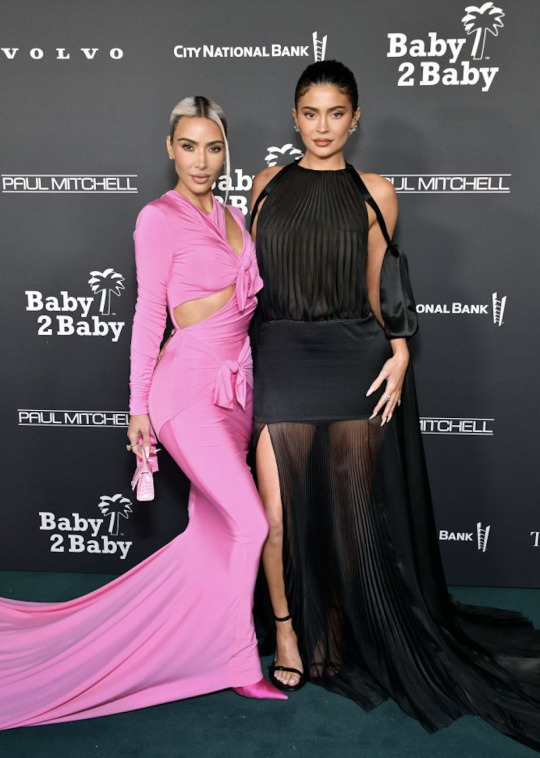
I don't like them but to say they haven't had an impact on beauty/fashion/pop culture would be lying. I personally see it as a negative impact 😬 but its an impact nonetheless.
They normalized plastic surgery to such an extent that every other girl in the West and almost every famous woman at this point has fillers, botox, BBL or something done. They also paved the way for influencers entering the fashion world.
Kim is Chitra Sun, UBP Moon & Jyeshta Rising with Mercury in Vishaka amatyakaraka and Venus in Purva phalguni atmakaraka
Kylie is Ashlesha Sun, Swati Moon & Purva ashada Rising
She has Venus in Uttaraphalguni atmakaraka & Saturn in Revati amatyakaraka
10. Bella Hadid
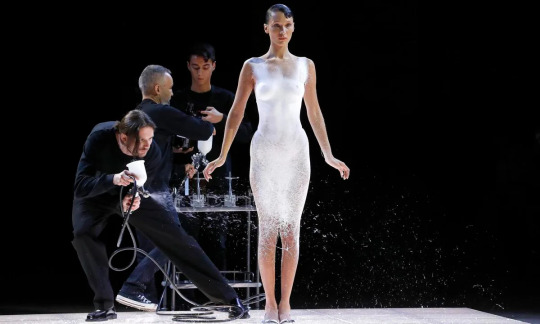
cannot talk about it girls and not mention Bella.
she's had such a massive impact on pop culture in the late 2010s & now in the 2020s. she made y2k style as popular as it is today and is probably the only true supermodel of our era.
She's Hasta Sun (amatyakaraka), Purva phalguni Moon & Rising with Ketu in UBP, Mars in Ashlesha atmakaraka

she's inspired practically The Weeknd's entire discography. He has Ketu in Ashlesha
it's interesting to me how all the Hadid siblings have inspired a lot of pop music. (Gigi with Zayn, Anwar with Dua Lipa etc)
11. Selena Gomez

Selena's inspired way too many heartbreak songs to not be on this list.
She's Pushya Sun & Rising with Aswini Moon with Ashlesha Mercury (atmakaraka) & Venus
There has been a lot of Vishaka women and Jupiter natives in general, Pushya ladies, Ketuvian (esp Aswini), Venusian influence and a lot of people with Ashlesha atmakaraka/amatyakaraka. Pisces influence and Jyeshta influence is also seen. Why are these planets/naks/rashis recurring?
Talking about people who have a very wide impact, it makes sense as to why Jupiter natives would be here; its expansiveness reaches everyone. In fact if you look at the era defining cultural figures of any decade, you will see a common Jupiter influence. This is also why Pisces rashi (Pisces is ruled by Jupiter) is so common in the world of art & entertainment.
Venusian placements are what creates trendsetters imo. Its what makes others imitate you and want to be like you.
Ashlesha natives dominate the entertainment sphere because entertainment and all art tbh, is in the simplest terms, manipulating others.
Pushya women inspire others with their feminine charms. Ketu being the root or the tail means that its very easy for others to project on to them. They lack identity on their own; its a very shadowy realm. This is what celebrities are to most people; you don't know them or understand them, which makes it easier to project onto them and love them for that illusion.
Jyeshta represents lack and in the world of influence, more than abundance, its that space of lack that makes it easier for people to add/built on to the persona they see of someone.
I'll make a part 2 sometime but for now this is it. I hope it was insightful.
#astrology notes#sidereal astrology#vedic astro notes#astrology observations#astrology#nakshatras#astroblr#astro observations#vedic astrology#astro notes#jyeshta#muses#pisces#pushya#venus#aswini
286 notes
·
View notes
Text
question to all cinephiles!
Reblog for sample size etc!
#ok THIRD TIME'S THE CHARM.#NOT the second new wave we are talking abt the OGs here!!! dont let me see yall write in wong kar-wai i WILL judge heavily#ling.txt#polls
147 notes
·
View notes
Text
DFF, Found Footage, Technology, and the Real
Okay so I've been slowly looking into horror and technology since watching Shadow, and now DFF has me going down a related research spiral. So let's call this a sibling post to my Shadow technology series (which I am slowly working on I promise).
I just thumbed through a great book on found footage horror and a few other pieces on technology and wanted to use these as a lens to think about DFF and how it's navigating a number of themes including the distinction between reality and fiction.

DFF draws on the concept of found footage films like The Blair Witch Project. Even if DFF's main framing and style isn't found footage, the film the characters are working on is. And we get our most direct reference to a horror film when Jin references The Blair Witch Project--an iconic found footage film. So I want to start by thinking about the Blair Witch Project.
Part 1: The Blair Witch Project and DFF
Part 2: Paranormal Activity, DFF, and the Myth of the Real
Part 3: Films within Films, Surveillance Technology, and Other Connections (Man Bites Dog, Cabin in the Woods, Shutter)
Part 1: The Blair Witch Project and DFF

While found footage horror doesn't purely originate with the Blair Witch Project it certainly rocketed the concept into the popular zeitgeist. I watched the film for the first time this week, and while it didn't scare me*, I could easily see how influential it would've been at the time. The media landscape looked very different in the late 90s, and the film's marketing deliberately played up the idea that this was real footage in a way that simply couldn't be done today with our current media landscape and familiarity with the found footage genre. We're now much more familiar with fakelore as a concept in general.
*The scariest part of watching was the censored subtitles! Stop that please! They seriously were replacing things like "Oh, fuck" with "Oh, boy." I also got a car add about going out to enjoy national parks, and how they can be accessible to Deaf people, which was an interesting moment of double irony.
In her book Found Footage Horror Films: Fear and the Appearance of Reality, which I will be citing quite a bit in this post, Alexandra Heller-Nicholas notes that the Blair Witch Project came out at a time when amateur films were still relegated to home videos but entering public viewing through shows like America's Funniest Home Videos. The style was thus associated much more closely with trying to capture reality than tell a fictional story. The marketing played into this heavily--for example: using the actors' names for the characters, circulating missing persons flyers in areas where the film was being shown, and creating a website that gave background on the Blair Witch myth and information on the "missing" trio of amateur filmmakers. I chatted a bit with @slayerkitty who saw it in theaters. She explained how part of what made the film scary at the time was how real so many people thought it was and the tension of being in the audience.
TBWP and DFF Similarities
Let's start by going over some of the ways DFF might be directly pulling from the film or making homages before jumping into what I think are probably the more significant thematic connections with found footage.
Myths and an Ambiguous Antagonist:

The Blair Witch Project is set against the backdrop of a local myth about a witch in the woods. Three young adults (Heather, Josh, and Mike) go to make an amateur documentary about the witch, get lost in the woods, and are then hunted by an unseen presence. We get information about the myth through interviews with locals and a book Heather reads aloud briefly called The Blair Witch Cult. We learn about the slaughter of 5 men (which is described almost like a ritual), disappearances and deaths, and a man who was compelled by the witch to slaughter children. Similarly in DFF we have our Janta cult, which slaughters people in the name of a supernatural or spiritual force. Now I'd say this could be a nod to TBWP but it also draws on plenty of other ghosts stories and urban legends about the woods. I'm sure there are also particularly Thai valences as well beyond just being Buddhist on the surface.
Like the trio in The Blair Witch Project, the group in DFF goes into the woods to film--though they aren't traipsing through the woods, and the horror they're filming is a story of their own creation. In the present, however, the horror becomes much more than fiction, just like in TBWP. In the film, we see and hear signs that something or someone is following the trio but it's ultimately unclear if it's supernatural, locals scaring them, or them slowly cracking and turning on one another. In DFF's opening episodes it's likewise unclear if what's happening is being caused by a person, hallucinogens, or something supernatural.
Maps and Marketing:

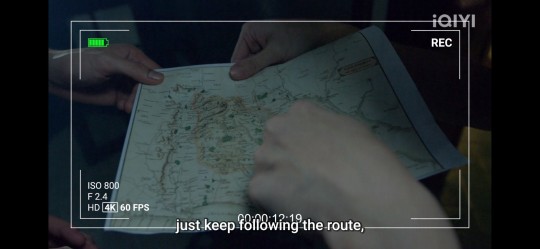
TBWP also shows the characters turning on one another, arguing, and cracking in a way that fundamentally sabotages their survival. At one point, Mike reveals that he threw their map, their only lifeline, into the river. This is paralleled in Fluke turning away their transport and means of leaving. The map is an important focus in the film. We see Heather orienting the group and insisting she knows where they're at, while Mike insists they're lost. This culminates in them losing the map as things start getting worse. DFF slips in what I read as a potentially more direct reference to the film in episode 8. An odd new detail in the group's film where they rely on the hope of a map to get out before they're attacked by the masked killer again.
Another potential similarity to draw on has more to do with the outside marketing of TBWP. Interestingly it was marketed to appear like an indie film despite having pretty extensive funding. This makes me think of the group's film in DFF. This is meant to be a student film but they received a huge boost via Por's dad giving them extra money for a camera.
Smoking and Being Alive:

One other parallel I find interesting is the emphasis on smoking. To be fair TBWP is probably not the first or last horror film to have people smoke (the pot head is a character trope of it's own), and I was likely primed to notice because we already had "Tan smokes and has asthma" on our list of clues for DFF. Now clearly the writers of DFF are smart and are using Tan/New smoking in plot relevant ways. These details feel purposeful to the story they're crafting. But let's briefly look at how smoking shows up in TBWP.
The characters all smoke and drink alcohol. As they get lost and the days tick away they run out of food and smokes. Josh has moments that could be attributed to withdrawal where he laments that they're out of cigarettes. However, after he disappears, Mike finds some remaining cigarettes at the bottom of one of their bags. Mike comments "We're still alive cause we're smoking." For him, it signals even if briefly that they are still alive, that they're surviving.

But in DFF, smoke seems to be attached to death and dissociation. We know that New is a smoker, something he perhaps picked up in England. It starts then as a sign that he has a life, one outside of being Tan. Yet it's that very life, being abroad, that led him to be so far from Non when he disappeared. For New, his life is now tinged with guilt and loss. As @syrena-del-mar noted here, there are moments where he forgets he is supposed to be New. But the smoking becomes his one reminder that "New" is still alive.
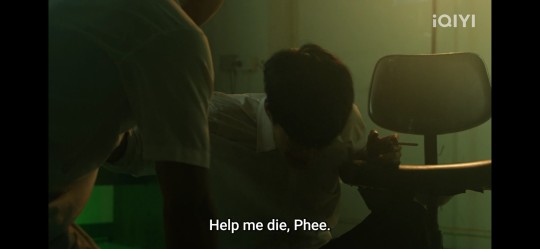
Yet this reminder turns more and more painful. Under the exterior of Tan, he is haunted by New, the brother who didn't make it in time. And this spirals further when his mother and father die. Each time he's a step closer but still too distant to stop their deaths. At this point, he starts getting high to a dangerous degree--dissociating, hallucinating, torturing himself with visions of Non. When Phi steps in we have a parallel moment to Phi stopping Non from taking pills. Smoking turns from a sign of life to one of death as New tries to commit suicide, telling Phi "I don't want to live anymore." And New takes this further when he drugs the rest of the boys. Perhaps he didn't intend it to go so far, but he certainly is happy with the result. His drugs, his smoke have caused fear and death, rather than hope and life.
Except for the map I feel like most of these parallels can as easily be chocked up to direct inspiration as they can be attributed to both pulling on a similar well of genre conventions. What I find more interesting is the thematic conversation TBWP brings to the table for DFF.
TBWP and Thematic Resonances with DFF
Filtered Reality:
In her work on horror, Brigid Cherry remarks that The Blair Witch Project is "about the way in which technology gets in the way of seeing" (qtd in Heller-Nicholas 23). Heller-Nicholas further notes how the camera is constantly in contention with the audience's desire to look at what we want to see. In the film itself, one of the characters even remarks that looking at the world through the camera is "like a filtered reality" because you "can pretend everything isn't exactly like it is."

This looking but not seeing resonates to me with Jin. He looks at Non through the camera, seeing him as innocent, in need of protecting. But there's so much he doesn't see about Non, including the reality of poverty. Jin's perfect view of Non breaks at the moment he sees Non with Keng. But as Jin's filtered vision of Non cracks, he adds a new filter. He frames Non as a slut, someone guilty in his mind, at least in the he heat of the moment. So he records him. In doing so, he papers over the nuances of the situation, that it is SA and that there is so much of Non's life that is outside of Jin's lens.

After Non's disappearance Jin doesn't stop using his camera lens to view the world. In episode 9, he watches the others play soccer and then Phi through his camera. He is pretending nothing happened just like the rest of the group, but for him to do that he has to filter his reality. And just like with Non, Jin isn't able to see the full story around Phi from this small frame of a perspective.

I also think it's worth noting how the show, especially in the flashbacks tends to use strong framing (I note some of this in episode 5 but it persists strongly at least up until episode 9). While they aren't using a found footage style, there's still a sense at times that the camera is limiting our view as it closes in around the characters. It's as if the camera frame becomes hyper-visible, similar but not exactly like in found footage. I'm not entirely sure how to read this just yet, but it feels appropriate for both a mystery and for a story so deeply invested in perceptions. There's a strong focus on what is made visible and what is rendered invisible by the characters, by the story structure, and by the frame of the camera itself.
Gender, Space, Control:
In her discussion of TBWP, Heller-Nicholas discusses the gendered dynamics of the film and how scholars have read the film as invested in the horror of female control. This is captured in two ways. First in the way the woods as a space become imbued with the horror of the Blair Witch (pulling on a tradition of witches being women), and thus the feminine. Second, in the way that Heather, who is the director of their film, leads the group to folly. Scholar Linda C. Badley, has argued that "Heather represents a serious breach in having taken possession of the conventionally male--and often murderous--gaze" (qtd. in Heller-Nicholas 108). Heather thus enters the domain of the typically masculine and the results are disastrous.
I find it interesting to compare DFF with TBWP in this respect because they've taken a genre that often is infused with binary gender dynamics and given us all men, and predominantly queer men. This is obviously a dynamic of BL, but it's interesting to consider how this plays with the themes of gender that often proliferate in horror. This is a much broader topic, and @brifrischu and I are currently reading through Carol Clover's seminal work Men, Women, and Chainsaws so I wager we'll have more to add to the discussion at some point.
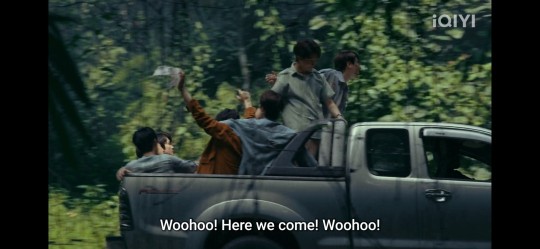
But let's look at a few things. First, if the Blair Witch imbues the woods as a space of feminine horror, DFF paints the woods as masculine. After our cold open, we are introduced to the group as they ride into the forest via Por's narration about the legend of Janta. The subtitles at the very least, refer to Janta using masculine pronouns. I don't want to assume that Thai gender coding and dynamics are identical to western ones but we might consider the way that the group of boys, packed into the back of a truck paint this as a masculine, homosocial space.
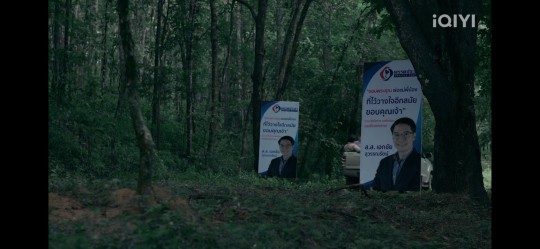
This is reinforced by the mention of Por's father. Por says "My dad warned me that, so I had to listen to him." This masculine authority is doubly highlighted by the campaign posters that literally mark his control of the space. To go any further the group must pass through these signs as a threshold to the space. Here we have not just masculinity being signaled but wealth, power, and control--something that contrasts distinctly with Non, for example, who has none of this. And of course, as we move through the story much of the horror comes from the actions of the core group of boys rather than the masked person we started with.
I find it interesting too that as Por tells the tale, it's White who comments "You almost had me scared." They then have a discussion about Tee liking to teaser "the younger ones." This focus on White as the most vulnerable is interesting given that he reads as perhaps the least traditionally masculine of the group*.
*Another reason why I'm excited to read Clover's work, is because she came up with the final girl formula in her discussion of gender in horror. I'd love to think about how we apply that in a queer context, especially given how so many of us have collectively felt White will be final girl. What might DFF be doing re: gender within the context of queerness, and what might it be asking of us as an audience?

The second aspect of this is the directorial gaze. In TBWP we have a woman taking on the control of a film project. This is important not just because Heather takes on a typically male profession but also because of the way films are imbued with what Laura Mulvey has termed "the male gaze." The view from which we see the world and the terms on which stories are told are traditionally male, while women are objects to be looked at--something Heather bucks and is punished for.
In DFF we have a similar struggle over authorship and directorial control. Instead of a strict division between feminine and masculine gazes, we get a struggle that is imbued with distinctions of class first and foremost. Por stands in as the more traditionally masculine director. We see the violence he does in trying to maintain control of the project. Of course he mostly does this through exerting his wealth. In contrast, Non doesn't fit the more aggressive masculine role, he comes from poverty, has mental illness, and is generally at the bottom of the social pyramid. His authorship comes into tension with Por's desires for directorial and social control.
There's a strong thematic exploration here of not just who gets to tell the story, but who's story gets to be told. In the end, the camera is Por's, his wealth and framing win out, and Non's authorship is buried. Much like the male gaze relegates women to objects rather than directors or authors, the only film that Non gets credit for is the sex tape in which he becomes objectified by the camera.
Of course we then have the fact that, in the present, Non's revenge script is being played out. There's a new director here, and clearly it's not entirely Phi (who tries his hand at directing in episode 1). Regardless of who is orchestrating these moves, we have an inversion of power happening. While we can't say for sure until the show has wrapped up, I suspect that DFF will lean into this inversion, rather than, like in TBWP, punishing this transgression of the norm.
That's all for now on TBWP, but certainly not all on DFF. I'm going to turn now to another important found footage film, Paranormal Activity, to unpack a bit more about DFF and it's themes.
Part 2: Paranormal Activity, DFF, and the Myth of the Real
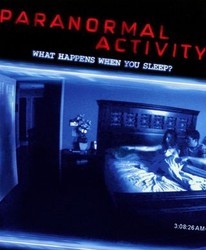
In her work Heller-Nicholas notes how, after Paranormal Activity hit the screen, our view of found footage as a genre shifted. It was no longer seen as necessarily authentic per-se but a stylistic form. Heller-Nicholas puts it like this:
As these more popular found footage horror films made their way to the forefront of the genre, what became important was not that the audience necessarily believed that they were real, but rather that they offered a framework to knowingly indulge in a horror fantasy of the real. The solidification of a recognizable found footage horror style meant that horror audiences understood and identified them as such, defining a subgenre where an authentic style (rather than claims of authenticity itself) prevailed
(Heller-Nichols, 128)
I won't go into smaller parallels between the film and DFF (partially because I haven't seen it, so if you have please add anything you notice), but I want to cover a few thematic resonances.
Heller-Nichols sketches out a few ways that critics have interpreted the film. First, as an allegory for materialism in the context of the US housing market crash of the time. Second, as a reflection on surveillance and the way changes in technology changed our relationship to cinema.
The first theme, materialism and consumption play out in the film through both the financial disparities of the characters and the more metaphorical spiritual/demonic possession that takes place. Both DFF (at least episodes 1-4) and Paranormal Activity take place in a luxurious house and themes of greed and materialism are present. In DFF, Por takes this role, flaunting his wealth and using it to get what he wants. Of all the characters, he is the one most willing to steal credit from Non. In Paranormal Activity the wealthy boyfriend even brags about buying a nice camera on only half-a-day's pay. Similarly Por brags about getting the nice camera for their film with his father's money.

One thing that set Paranormal Activity apart from earlier found footage films like The Blair Witch Project, was it's use of security camera footage. It relied on a new type of gaze that made the private public in the context of shifting surveillance technologies. While DFF largely centers itself around a film camera, it also includes other forms of technology in the background, including surveillance cameras. The CCTV cameras in Por's house come to mind as a significant way this technology comes into play. On the one hand, it helps Por identify that there is an intruder, and it helps the group find him when he is hurt. On the other hand, it encroaches on the private, capturing White and Tee having sex. This private vs public line is of course horrifically crossed when Jin records Non and Keng and when this video is circulated--surveillance right in our hands via cell phone.

Heller-Nicholas notes that post-Blair Witch, and by the time Paranormal Activity was released, audiences were much more genre savvy. She notes that the genre's "pleasures are not reliant on our gullibility, but rather our willingness to succumb to the myth of the real that these films offer..." (26). Relevant to DFF, I want to stress the "willingness to succumb to the myth of the real." I discussed earlier how Jin doesn't see Non; instead, he is happy to succumb to a myth of what could be the real Non.
But it's not just Jin who does this. Almost everyone around Non believes they see him correctly--as "Greasy", as a bad son, as a cheater, etc. This takes on even more public dimensions as the police enter the picture, as the sex tape circulates, and as the police report that he has run away with Keng. What people see and believe about Non, the narratives they tell about him, help reinforce people's existing understandings of the world--their prejudices, their assumptions, their myths of how the real world works.

And of course, film is at the center of this. The police believe that Non wasn't with the group when he disappeared because any footage he was in was hidden from them. Non is erased from the film (both in the footage and in terms of credit). The entire film premier is one big moment where everyone in the group is playing into this myth. It is taken as fact that Por's name being in the credits means this is his work--that nothing or no one of note was hidden behind the frame.
In her work Heller-Nicholas points to discovered manuscript fiction (such as Dracula) as a precursor to found footage horror. This connection highlights the way these works rely on the fiction that someone has organized the documents apart from the original author. The fictional framing of found footage as pretending to have an original author or filmmaker other than the actual director, hides the fact that The Hidden Character has in many ways literally stolen credit from Non. The genre expectations obfuscate the real story.
And then there's the sex recording (the only film Non gets credit for). We see a number of reactions to the recording from people in Non's life as well as those outside of it. The social media posts in particular stress the way Non's vulnerability is quickly slotted into pre-held narratives of sex and sexuality that refuse to see the reality of SA.
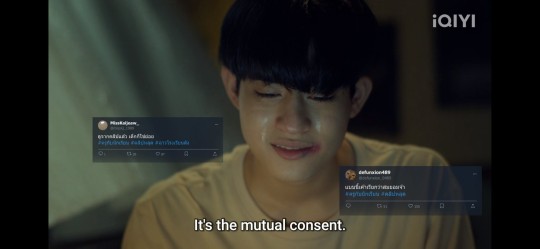
Non's SA is taken as truthful evidence of his consent via social media, while the film the group made is found footage but not seen as real. I think this marks an interesting change in the aesthetics and narratives we find "real." Horror and found footage are legible, a chance to engage in "a fantasy of the real". Meanwhile, the real story behind the film is erased, just like Non. Sadly, the most legible narrative of a young queer boy is that the phone footage is slutty or even hot. No one questions the authenticity of the recording, it is viewed as real. Ironically, compared to the horror film the group shoots, the sex tape is the real found footage film. Yet the "reality" it shows is filtered through interpretation. Non's reality gets buried.
Meanwhile, as an audience, we have the opposite reaction. We are slowly given insight into the discrepancy between Non's reality and the myths people hold. We keep asking why other characters can't or won't see the truth, why they won't help Non until it's too late.
DFF may not be found footage itself, but it is certainly interested in exploring and extending the thematic conversations about authenticity, reality, and narrative.
Part 3: Films within Films, Surveillance Technology, and Other Connections
Despite the fact that DFF references and dialogues with the found footage horror genre, it formally has more in common with films that center around technology and films within films. So I wanted to cover three more films that I think dialogue in interesting ways.
Man Bites Dog:
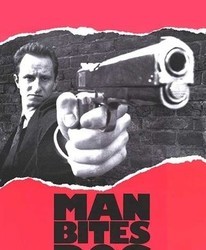
I'll start with Man Bites Dog since I have the least to say about it. It is a 1992 French mockumentary and black comedy, that Heller-Nicholas notes is a pretty significant and well-acknowledged precursor to the found footage horror genre. I'm not sure I want to get to deep into themes with this one. But I thought the parallels were interesting. A film crew decides to make a documentary where they follow a serial killer named Ben around only to be pulled into the crimes and become culpable themselves. That is, until Ben is killed and the film crew are taken out one by one by an unknown killer. We have a film crew that slowly gets involved and more culpable in wrong doings, just like in DFF we have the group working on a film while slowly becoming more and more culpable in harming Non. Meanwhile in the present both "film crews" are suddenly being hunted and picked off by an unknown party.
Cabin in the Woods:

Cabin in the Woods is a 2011 film that satirizes horror. A group of college students go to a cabin in the woods and are slowly picked off. The twist is that this is all orchestrated by an organization that is simultaneously surveilling and orchestrating their deaths to appease ancient deities. Many of the shots are done through drone's and other similar visuals to highlight the way the group is being surveilled. In a chapter from a collection on horror and gender, Hannah Bonner looks at Cabin in the Woods and a few other films that include surveillance and social media. She discusses the way technology in these films revolve around slut shaming young women. As she puts it, "It is the 'fact of being constantly seen', whether by high key government surveillance systems or by judgemental peers, that throws these characters into disarray or death" (89).

For Cabin in the Woods one thing Bonner examines is the way the film frames the group's "slut" character Jules. Jules and one of the guys go outside to get intimate. And the film moves between this scene and the men surveilling them who watch eagerly. Bonner reads this as a commentary on the violent gaze with which horror frames women. She makes a distinction, noting that "The voyeur is no longer just the audience, squirming in their seats from Michael Meyers's point of view as he tracks down his naked sister and her boyfriend in Halloween...now the audience as voyeur watches the voyeurs watch the surveyed" (90).
DFF makes a similar move by staging multiple instances of filming (a film within a film, or in this case a film within a show). We get a moment in episode 1 where Tee steps forward to block the group watching the CCTV footage of him and White. But this denial is in contrast to other moments. The show draws us most into being voyeurs watching voyeurs, when Jin films Non. I think it's important to note that both the moment that Bonner discusses in her chapter and this moment in DFF are sexual. In CITW, Jules is literally labeled by her surveillers as "the slut", a role she must fulfill and be killed for to appease the gods. Her lack of agency is made quite apparent. In DFF, Non is also slotted into the role of the slut by those around him, including Jin when he films the moment out of anger. While the show is not as on the nose about the whole thing, it's still clearly establishing a discrepancy between how Non is viewed by those around him due to the tape and the lack of full agency he possesses.

Moreover, by making us viewers voyeurs of this voyeurism, DFF creates a critique rather than simply a simulation of voyeurism. I am considering how this might not just be a commentary on sex shaming, but sexuality within a space where BL has historically crossed the line at times in terms of depicting SA. Or even the way that BL actors in Thailand are often expected to blur the line between the private and the public through fan service. It's interesting because clearly the show also doesn't shy away from letting us be voyeurs to sex. The show perhaps draws a distinction between representing queer sex and SA. But it's fascinating how this is mediated through voyeurism and the camera's gaze.
Shutter:
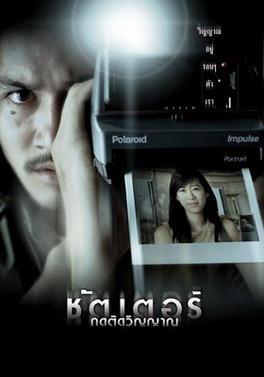
I couldn't wrap this post up without talking a bit about Shutter. Shutter is a 2004 Thai horror film (and probably Thailand's most well known horror film globally). It was part of the horror boom of the late 90s and early aughts in Thailand and Asia. If you throw Thai horror and cameras my way, I will think of Shutter. I watched it as part of some research I've been slowly doing on late 90s/early 2000s Asian horror and technology (writing meta for Shadow the series). It's a story about haunting that takes inspiration from the idea of spirit photography.

The film follows a couple, Jane and Tun, both photographers, who start seeing shadows and faces in their photos. Jane discovers that the ghost is a girl named Natre who Tun used to date in secret. They proceed by trying to figure out how Natre died (suicide) and how to get her to move on. Meanwhile Tun's friends suddenly start killing themselves. Ultimately Jane learns that Tun's friends raped Natre, and Tun not only didn't stop them but even photographed the assault at his friends' request (so Natre wouldn't snitch). Jane confronts Tun who expresses his regret, that he "never forgave [himself]." In the climax of the film Tun uses a polaroid camera to try and find Natre's ghost in real time before being driven out the window. Natre let's him live, in a near catatonic state, unlike his other friends because his betrayal hurt the most.

We once again come back to themes of voyeurism, SA, peer pressure, and culpability. The film has strong focus on the effects and betrayal of being a bystander, much like DFF does. Again this parallel is made quite strongly with Jin. Non may not have had feelings for him, but he is the kindest of the group, making his betrayal hit strongly. Jin filming Non and Keng has it's own nuances within DFF, but it certainly parallels Tun photographing Natre's assault. Similar to Non, Natre disappears in the aftermath, while Tun and his friends go on with their lives.

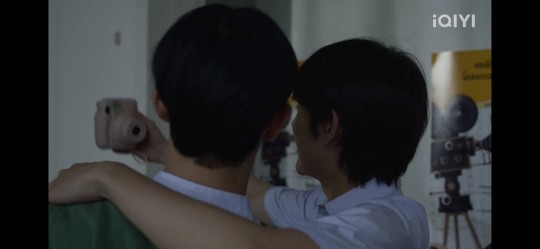
On a smaller note, both Tun and Jin use polaroids in what is potentially a reference to the film.
As the truth is revealed, Tun goes from a protagonist to a villain, and Natre goes from the horror of the story to the victim. DFF seems equally interested in the idea of how truths get hidden and justice withheld. It also gives us an inversion of the source of horror. By the time we end episode 5, the group we've gotten to know over four episodes are clearly villains in our minds, their cruelty becomes the horror rather than the masked killer who we come to empathize with (or at least root for to some degree). Now how this fully plays out in the end might shift things. But currently (up through episode 9) this is a horror story locating horror in power and cruelty rather than simply reinforcing a more conservative world view of the non-normative monster.
Concluding Thoughts
Dead Friend Forever is mixing genres in a smart and deft way. It's clear that the writers and director are well versed in horror and are ready to play with genre conventions to deliver their ideas and themes. Some of the connections I'm making here might be happy coincidence where the works speak to each other mediated by my own perspectives and interpretation. But I also believe that the show is building on themes and traditions in horror and found footage horror specifically in smart ways. From the framing of shots, to the way they deftly speak to themes of (in)visibility, power, reality vs fiction, agency, and sexuality (among others).
Through all this, DFF has been incredibly genre savvy. While found footage plays on the idea of reality, DFF shakes that up by throwing a who-done-it mystery our way. Like in The Blair Witch Project, for much of the show, we don't know what's real or what's in the characters' heads. DFF, however, picks up where TBWP stops. At the end of TBWP, the characters are likely killed off camera, the source of the horror still left up in the air. DFF gives us this ambiguity, but then pivots and makes the show a mystery to solve rather than locating the horror in ambiguity. This is because the horror lies elsewhere. Like in Shutter, the monster becomes the victim, our sympathies are played with, and we're left with a show that is as interested in social and political critique as it is in having fun playing with horror tropes.
Sources:
Heller-Nicholas, Alexandra. Found Footage Horror Films: Fear and the Appearance of Reality. McFarland & Company, 2014.
Badley, Linda. Film, Horror, and the Body Fantastic: Praeger, 1995.
Bonner, Hannah. “#Selfveillance: Horror’s Slut Shaming through Social Media, Sur- and Selfveillance.” Gender and Contemporary Horror in Film, edited by Samantha Holland et al., Emerald Publishing, 2019, pp. 85–99.
Cherry, Brigid. Horror. Routledge, 2009.
Shutter (film, 2004)
Cabin in the Woods (film, 2011)
Man Bites Dog (film, 1992)
The Blair Witch Project (film, 1999)
Paranormal Activity (film, 2007)
#i think next i want to write a piece on Tan/New and the way the show is drawing on the mad scientist sub-genre#dead friend forever#dff the series#dff meta#my posts#my meta#dead friend forever meta
79 notes
·
View notes
Text
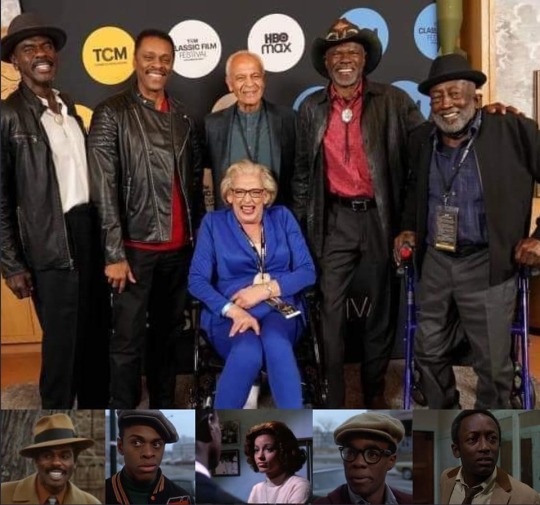
A 'COOLEY HIGH' REUNION
AT THE 2022 TCM CLASSIC FILM FESTIVAL IN LOS ANGELES, CA
Steven Williams (73), Lawrence Hilton-Jacobs (68), director Michael Schultz (83; middle back row), Cynthia Davis (63), Glynn Turman (75), and Garrett Morris (85) attend the screening of "Cooley High".
One of the most influential African American films of the 1970s, this coming-of-age tale was inspired by writer Eric Monte’s experience growing up in Chicago’s Cabrini-Green housing project, where he attended the real Cooley Vocational High School. Indie studio American International Pictures developed his story and had the wisdom to hire a Black director, Michael Schultz, to shoot the low-budget film on location. Glynn Turman stars as Preach, who dreams of writing plays while palling around with basketball champ Cochise (Lawrence Hilton-Jacobs). Their episodic adventures and a soundtrack filled with Motown classics helped turn the picture into one of the year’s biggest hits.
It had a major influence on writer-director-actor Robert Townsend—who had a one-line bit—and John Singleton, among other Black filmmakers who saw its use of three-dimensional characters and focus on friendship as a breakthrough. It also inspired the hit TV series What’s Happening!!
127 notes
·
View notes
Text
The Future Is Noir
Scenography for the darkness with the uncertain future. Architecture of fear in the cinema of 1920s.

Considered the quintessential work of German expressionist cinema, the Cabinet of Dr. Caligari (1920) by Robert Wiene tells the story of an insane hypnotist who uses a brainwashed somnambulist to commit murders.
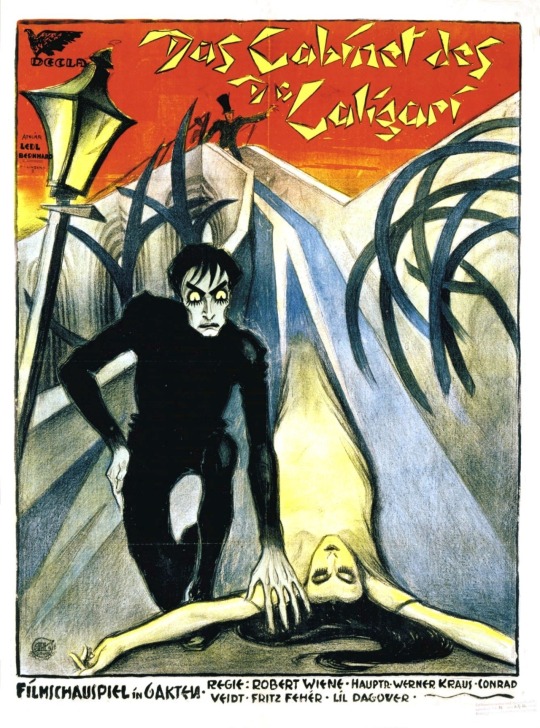
youtube
The film thematizes brutal and irrational authority. Caligari can be representing the German war government, with the symbolic of the common man conditioned to kill. The film include the destabilized contrast between the subjective perception of reality, and the duality of human nature.

An unofficial adaptation of Bram Stoker's 1897 novel Dracula in film is the German version of Nosferatu: A Symphony of Horror (1922) by F. W. Murnau. Nosferatu is an archaic Romanian word Nesuferitu` meaning the offensive or the insufferable one. The movie is actually about the First World War and the plague is a metaphor for the mass death and destruction of the war.

youtube
Nosferatu was banned in Sweden due to excessive horror until 1972. All known prints and negatives were destroyed under the terms of settlement of a lawsuit by Bram Stoker's widow.

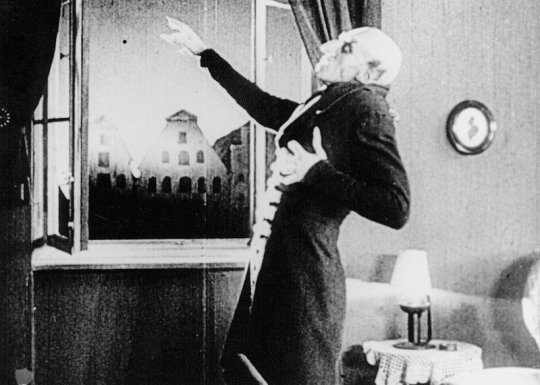
Berlin – Die Sinfonie der Großstadt (1927) is an experimental documentary by Walther Ruttmann. It begins with a drive of a high-speed train pulled by a steam locomotive through meadows, arbor and residential areas into the city and thus delimits the surrounding area from the big city.

The train arrives at Anhalter Bahnhof near the city center, where streets empty in the morning are filling up with people on their way to work. The rhythm of the city is getting faster and faster. With the 12 o'clock bell strike, the speed collapses. After lunch break and food intake, however, it begins to accelerate again in the afternoon.
youtube

Cabiria (1914), an Italian epic silent film by Giovanni Pastrone, was shot in Turin. The film is set in ancient Sicily, Carthage, and Cirta during the period of the Second Punic War (218–202 BC).

It follows a melodramatic main plot about an abducted little girl, Cabiria, and features an eruption of Mount Etna, heinous religious rituals in Carthage, the alpine trek of Hannibal, Archimedes' defeat of the Roman fleet at the Siege of Syracuse and Scipio maneuvering in North Africa.
youtube

One the most influential films in cinema history, Dziga Vertov's exhilarating ode to Bolshevik Russia the Man with a Movie Camera (1929). It is a visual argument for the place of the documentary filmmaker as a worker, educator, and eyewitness in a proletariat society. The film is an impressionistic view of urban daily life, seen from a purely cinematic perspective.

youtube


77 notes
·
View notes
Note
would you please elaborate on your comment "renowned hack frank miller" ? i haven't read much from him yet but i like to listen to informed people tell me why [thing] sucks because it's funnier than dc wiki
when someone tells me their favourite comic writer is frank miller my response is the same as when someone tells me their favourite films are american psycho and fight club — i immediately prepare for an irish exit from the convo.
both (some of) miller’s work and those films are influential pieces of art with explicit political ideology, but while american psycho and fight club are (frequently) misinterpreted satire, miller is genuine to the point of hilarity.
if u consume batman as a character in any capacity u cannot escape miller’s influence — batman: year one is the pretty definitive starting point for most fans (and filmmakers, like matt reeves with the batman 2022), and miller’s visual style is a cornerstone for modern comics. the dark knight returns effectively changed how comics were viewed by readers, and is credited with kickstarting the modern age of comic books. i cannot emphasise that even if u haven’t read a miller book u have certainly encountered someone else inspired by his work.
with that said — miller writes like how a racist libertarian who believes his own hype would write about superheroes. greta, u must be wondering, that seems like an awfully specific descriptor to assign to someone. and normally u would be right!
the because im batman schtick that every sixteen year old nolan stan with a twitter account ran into the ground circa 2014 started because of miller, and his success in the 80s led to a number of ill advised projects fueled by his own hype. all star batman and robin was an uncritical interpretation of bruce that embodies all the worst misinterpretations of dc characters, including the justice league, that miller then tried to espouse was satire. unfortunately, he is not smart enough to punch up instead of down — the absurd hypersexualisation of women doesn’t become satire just because you’re laughing at readers in the script, frank.
this, in turn, led to one of the most virulently racist comics ever published — 2011’s islamophic nightmare fuel holy terror. he should not be taken seriously as a creative force, and he should not be the foundation of what comics should be. at least alan moore is marginally less obnoxious and fully admits that the killing joke was a bad idea.
#it’s also worth saying that his art is so fucking ugly#batman#dc comics#the ask and the answer#all my homies hate frank miller#i think about the linkara review of all star batman and robin whenever i need to see a man have a full mental breakdown on camera
112 notes
·
View notes
Text
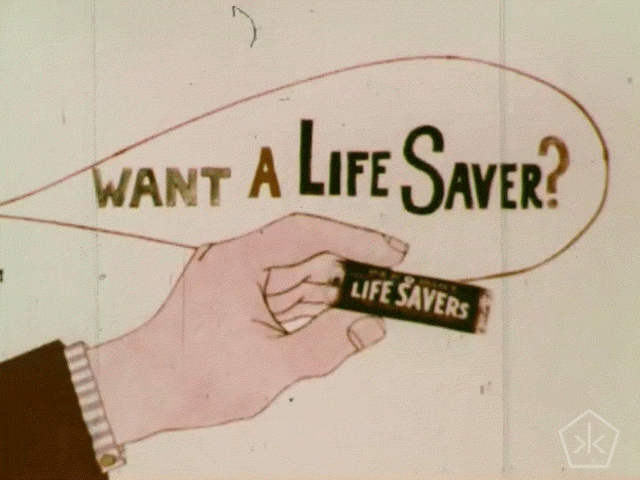
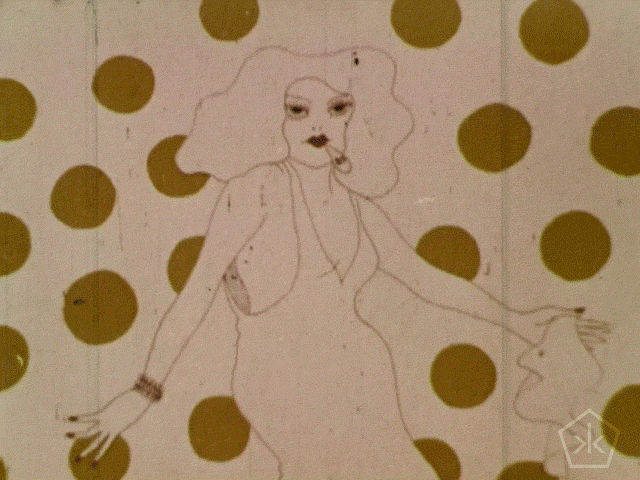
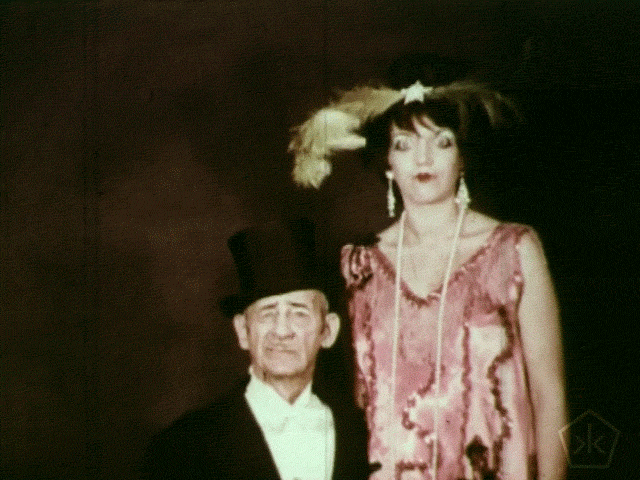
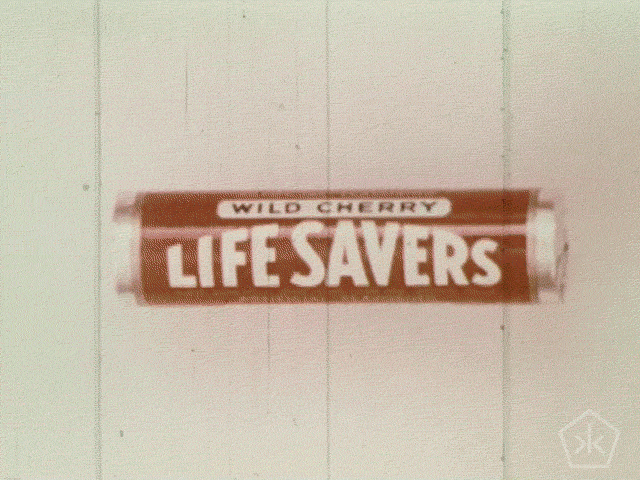
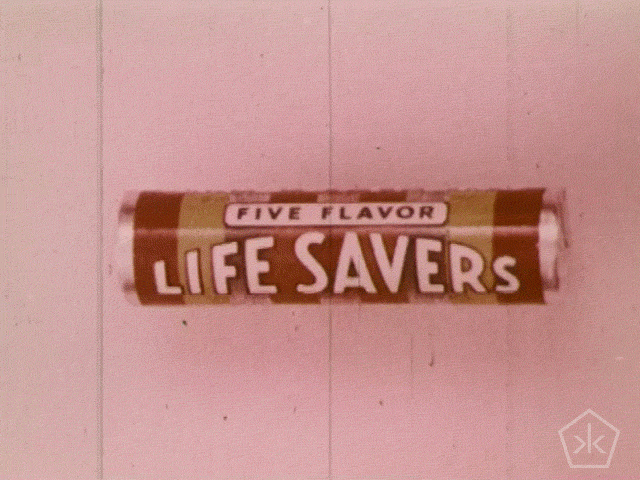
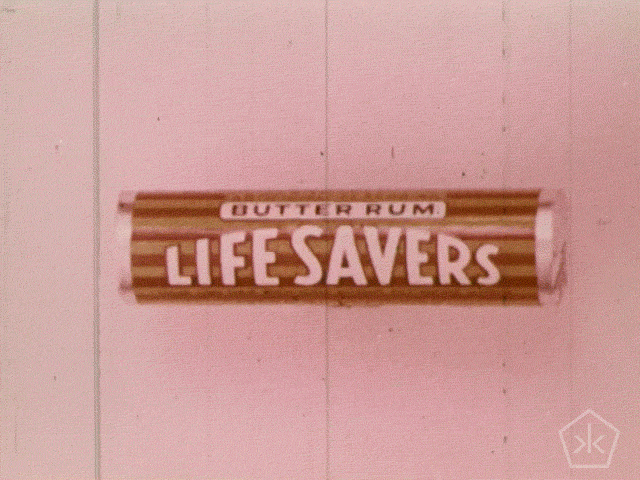

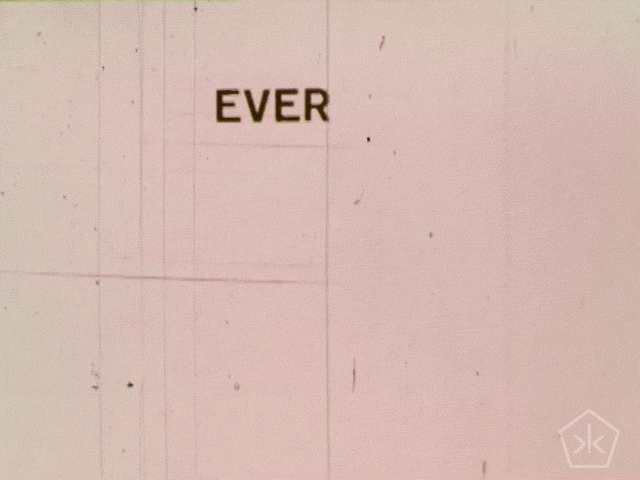
Excerpts: BEECH-NUT LIFESAVERS Commercial by Fred Mogubgub (1966)
'Beech-nut LIfesavers' is a commecial created by Fred Mogubgub (1928–1989), an influential figure in the world of animation and painting, particularly known for his contributions to the pop art movement during the 1960s in New York City. His career gained significant momentum when he co-founded Ferro, Mogubgub and Schwartz in 1961 alongside designer Pablo Ferro and Lew Schwartz. However, Mogubgub's creative ambitions led him to leave the company in 1964 to establish his own firm, Mogubgub, Ltd.
Mogubgub's artistic style is characterized by its rapid, staccato jump-cuts—an innovative blend of cartoons and photographs that flash across the screen, creating an effect that could be likened to subliminal advertising. His work, which often featured iconic American objects, was celebrated for its ability to capture the essence of American pop culture in a unique and engaging way. Among his notable commercial clients were Ford, Coca-Cola, and Life Savers, with his creations leaving a lasting impression on audiences due to their memorable and distinctive style.
His commercial work was groundbreaking, and several of Mogubgub's films have been recognized by the Museum of Modern Art for their innovative approach to animation and advertising. One of his most famous pop artworks was a large-scale sign erected in Manhattan in 1965, provocatively asking, "Why Doesn't Someone Give Mogubgub Ltd. Two Million Dollars to Make a Movie?" This piece reflected Mogubgub's bold and creative spirit, showcasing his ability to blend art with advertising in unprecedented ways.
Mogubgub's work extended beyond commercial advertisements to include underground short films that merged animation, illustration, and live action. One of his notable films, "The Pop Show" (1966), featured Gloria Steinem and demonstrated Mogubgub's adeptness at navigating the avant-garde film scene. Despite his significant contributions, Mogubgub's name is often omitted from discussions on avant-garde and experimental film from the late 1960s and early 1970s. However, his films were included in underground screenings, such as the 1970 New York Underground Film Festival, highlighting his role in the experimental film movement.
Fred Mogubgub passed away in 1989 at the age of 61 from bone cancer. Despite his death, his creative legacy continues to inspire animators and filmmakers, illustrating the enduring impact of his work on both the commercial and artistic realms of animation and pop art.
| Hosted at: Internet Archive | Full Video Download: MPEG4
‘The EXCERPTS series by OKKULT Motion Pictures transforms images from open source films of important historical and artistic merit into the internet drug we’ve come to love: GIFs!’ (Vice)
(Thanks to archive.org)
#gif#vintage#okkult motion pictures#excerpts#gif art#gifs#open knowledge#okkult#tv commercial#commercial#pop art#cartoon#animation#new york#1960s
54 notes
·
View notes